Post-Process Treatments on Supersonic Cold Sprayed Coatings: A Review
Abstract
1. Introduction
2. Heat Treatment
3. Friction-Stir Processing Treatment
4. Shot Peening Treatment
5. Laser Re-Melting Treatment
6. Other Post-Process Treatments
7. Summary and Outlook
Author Contributions
Funding
Acknowledgments
Conflicts of Interest
References
- Yin, S.; Cavaliere, P.; Aldwell, B.; Jenkins, R.; Liao, H.; Li, W.; Lupoi, R. Cold spray additive manufacturing and repair: Fundamentals and applications. Addit. Manuf. 2018, 21, 628–650. [Google Scholar] [CrossRef]
- Papyrin, A.; Kosarev, V.; Klinkov, S.; Alkhimov, A.; Fomin, V.M. Cold Spray Technology; Elsevier: Amsterdam, The Netherlands, 2006. [Google Scholar]
- Assadi, H.; Gärtner, F.; Stoltenhoff, T.; Kreye, H. Bonding mechanism in cold gas spraying. Acta Mater. 2003, 51, 4379–4394. [Google Scholar] [CrossRef]
- Villafuerte, J. Modern Cold Spray: Materials, Process, and Applications; Springer: Berlin, Germany, 2015. [Google Scholar]
- Assadi, H.; Kreye, H.; Gärtner, F.; Klassen, T. Cold spraying—A materials perspective. Acta Mater. 2016, 116, 382–407. [Google Scholar] [CrossRef]
- Moridi, A.; Hassani-Gangaraj, S.M.; Guagliano, M.; Dao, M. Cold spray coating: Review of material systems and future perspectives. Surf. Eng. 2014, 30, 369–395. [Google Scholar] [CrossRef]
- An, S.; Joshi, B.; Yarin, A.L.; Swihart, M.T.; Yoon, S.S. Supersonic Cold Spraying for Energy and Environmental Applications: One-Step Scalable Coating Technology for Advanced Micro- and Nanotextured Materials. Adv. Mater. 2020, 32, 1905028. [Google Scholar] [CrossRef]
- Champagne, V.K. The Cold Spray Materials Deposition Process; Elsevier: Amsterdam, The Netherlands, 2007. [Google Scholar]
- Ichikawa, Y.; Tokoro, R.; Tanno, M.; Ogawa, K. Elucidation of cold-spray deposition mechanism by auger electron spectroscopic evaluation of bonding interface oxide film. Acta Mater. 2019, 164, 39–49. [Google Scholar] [CrossRef]
- Hassani-Gangaraj, M.; Veysset, D.; Champagne, V.K.; Nelson, K.A.; Schuh, C.A. Adiabatic shear instability is not necessary for adhesion in cold spray. Acta Mater. 2018, 158, 430–439. [Google Scholar] [CrossRef]
- Champagne, V.; Helfritch, D.; Leyman, P.; Lempicki, R.; Grendahl, S. The effects of gas and metal characteristics on sprayed metal coatings. Model. Simul. Mater. Sci. Eng. 2005, 13, 1119–1128. [Google Scholar] [CrossRef]
- Champagne, V.K.; West, M.K.; Reza Rokni, M.; Curtis, T.; Champagne, V.; McNally, B. Joining of Cast ZE41A Mg to Wrought 6061 Al by the Cold Spray Process and Friction Stir Welding. J. Therm. Spray Technol. 2015, 25, 143–159. [Google Scholar] [CrossRef]
- Sun, W.; Tan, A.W.Y.; Marinescu, I.; Toh, W.Q.; Liu, E. Adhesion, tribological and corrosion properties of cold-sprayed CoCrMo and Ti6Al4V coatings on 6061-T651 Al alloy. Surf. Coat. Technol. 2017, 326, 291–298. [Google Scholar] [CrossRef]
- Champagne, V.K.; Helfritch, D.; Leyman, P.; Grendahl, S.; Klotz, B. Interface Material Mixing Formed by the Deposition of Copper on Aluminum by Means of the Cold Spray Process. J. Therm. Spray Technol. 2005, 14, 330–334. [Google Scholar] [CrossRef]
- Ko, K.H.; Choi, J.O.; Lee, H. Intermixing and interfacial morphology of cold-sprayed Al coatings on steel. Mater. Lett. 2014, 136, 45–47. [Google Scholar] [CrossRef]
- Bae, G.; Kumar, S.; Yoon, S.; Kang, K.; Na, H.; Kim, H.-J.; Lee, C. Bonding features and associated mechanisms in kinetic sprayed titanium coatings. Acta Mater. 2009, 57, 5654–5666. [Google Scholar] [CrossRef]
- Guetta, S.; Berger, M.H.; Borit, F.; Guipont, V.; Jeandin, M.; Boustie, M.; Ichikawa, Y.; Sakaguchi, K.; Ogawa, K. Influence of Particle Velocity on Adhesion of Cold-Sprayed Splats. J. Therm. Spray Technol. 2009, 18, 331–342. [Google Scholar] [CrossRef]
- Barmouz, M.; Givi, M.K.B. Fabrication of in situ Cu/SiC composites using multi-pass friction stir processing: Evaluation of microstructural, porosity, mechanical and electrical behavior. Compos. Part A Appl. Sci. Manuf. 2011, 42, 1445–1453. [Google Scholar] [CrossRef]
- Luzin, V.; Spencer, K.; Zhang, M.X. Residual stress and thermo-mechanical properties of cold spray metal coatings. Acta Mater. 2011, 59, 1259–1270. [Google Scholar] [CrossRef]
- Saleh, M.; Luzin, V.; Spencer, K. Analysis of the residual stress and bonding mechanism in the cold spray technique using experimental and numerical methods. Surf. Coat. Technol. 2014, 252, 15–28. [Google Scholar] [CrossRef]
- Spencer, K.; Luzin, V.; Matthews, N.; Zhang, M.X. Residual stresses in cold spray Al coatings: The effect of alloying and of process parameters. Surf. Coat. Technol. 2012, 206, 4249–4255. [Google Scholar] [CrossRef]
- Boruah, D.; Ahmad, B.; Lee, T.L.; Kabra, S.; Syed, A.K.; McNutt, P.; Doré, M.; Zhang, X. Evaluation of residual stresses induced by cold spraying of Ti-6Al-4V on Ti-6Al-4V substrates. Surf. Coat. Technol. 2019, 374, 591–602. [Google Scholar] [CrossRef]
- Spencer, K.; Zhang, M.X. Heat treatment of cold spray coatings to form protective intermetallic layers. Scr. Mater. 2009, 61, 44–47. [Google Scholar] [CrossRef]
- Sudharshan Phani, P.; Srinivasa Rao, D.; Joshi, S.V.; Sundararajan, G. Effect of Process Parameters and Heat Treatments on Properties of Cold Sprayed Copper Coatings. J. Therm. Spray Technol. 2007, 16, 425–434. [Google Scholar] [CrossRef]
- Kumar, S.; Jyothirmayi, A.; Wasekar, N.; Joshi, S.V. Influence of annealing on mechanical and electrochemical properties of cold sprayed niobium coatings. Surf. Coat. Technol. 2016, 296, 124–135. [Google Scholar] [CrossRef]
- Yin, S.; Cizek, J.; Yan, X.; Lupoi, R. Annealing strategies for enhancing mechanical properties of additively manufactured 316L stainless steel deposited by cold spray. Surf. Coat. Technol. 2019, 370, 353–361. [Google Scholar] [CrossRef]
- Yu, J.S.; Kim, H.J.; Oh, I.H.; Lee, K.A. Densification and Purification of Cold Sprayed Ti Coating Layer by Using Annealing in Different Heat Treatment Environments. Adv. Mater. Res. 2012, 602–604, 1604–1608. [Google Scholar] [CrossRef]
- Huang, R.; Sone, M.; Ma, W.; Fukanuma, H. The effects of heat treatment on the mechanical properties of cold-sprayed coatings. Surf. Coat. Technol. 2015, 261, 278–288. [Google Scholar] [CrossRef]
- Yang, K.; Li, W.; Yang, X.; Xu, Y.; Vairis, A. Effect of heat treatment on the inherent anisotropy of cold sprayed copper deposits. Surf. Coat. Technol. 2018, 350, 519–530. [Google Scholar] [CrossRef]
- Li, W.Y.; Guo, X.P.; Verdy, C.; Dembinski, L.; Liao, H.L.; Coddet, C. Improvement of microstructure and property of cold-sprayed Cu–4at.%Cr–2at.%Nb alloy by heat treatment. Scr. Mater. 2006, 55, 327–330. [Google Scholar] [CrossRef]
- Rokni, M.R.; Widener, C.A.; Champagne, V.K.; Crawford, G.A. Microstructure and mechanical properties of cold sprayed 7075 deposition during non-isothermal annealing. Surf. Coat. Technol. 2015, 276, 305–315. [Google Scholar] [CrossRef]
- Lee, H.Y.; Jung, S.H.; Lee, S.Y.; Ko, K.H. Fabrication of cold sprayed Al-intermetallic compounds coatings by post annealing. Mater. Sci. Eng. A 2006, 433, 139–143. [Google Scholar] [CrossRef]
- Yang, G.-J.; Wang, H.-T.; Li, C.-J.; Li, C.-X. Effect of annealing on the microstructure and erosion performance of cold-sprayed FeAl intermetallic coatings. Surf. Coat. Technol. 2011, 205, 5502–5509. [Google Scholar] [CrossRef]
- Meng, X.-M.; Zhang, J.-B.; Han, W.; Zhao, J.; Liang, Y.-L. Influence of annealing treatment on the microstructure and mechanical performance of cold sprayed 304 stainless steel coating. Appl. Surf. Sci. 2011, 258, 700–704. [Google Scholar] [CrossRef]
- Ren, Y.Q.; King, P.C.; Yang, Y.S.; Xiao, T.Q.; Chu, C.; Gulizia, S.; Murphy, A.B. Characterization of heat treatment-induced pore structure changes in cold-sprayed titanium. Mater. Charact. 2017, 132, 69–75. [Google Scholar] [CrossRef]
- Tang, J.; Saha, G.C.; Richter, P.; Kondás, J.; Colella, A.; Matteazzi, P. Effects of Post-spray Heat Treatment on Hardness and Wear Properties of Ti-WC High-Pressure Cold Spray Coatings. J. Therm. Spray Technol. 2018, 27, 1153–1164. [Google Scholar] [CrossRef]
- Sun, W.; Bhowmik, A.; Tan, A.W.-Y.; Li, R.; Xue, F.; Marinescu, I.; Liu, E. Improving microstructural and mechanical characteristics of cold-sprayed Inconel 718 deposits via local induction heat treatment. J. Alloys Compd. 2019, 797, 1268–1279. [Google Scholar] [CrossRef]
- Ma, W.; Xie, Y.; Chen, C.; Fukanuma, H.; Wang, J.; Ren, Z.; Huang, R. Microstructural and mechanical properties of high-performance Inconel 718 alloy by cold spraying. J. Alloys Compd. 2019, 792, 456–467. [Google Scholar] [CrossRef]
- Wong, W.; Irissou, E.; Vo, P.; Sone, M.; Bernier, F.; Legoux, J.G.; Fukanuma, H.; Yue, S. Cold Spray Forming of Inconel 718. J. Therm. Spray Technol. 2012, 22, 413–421. [Google Scholar] [CrossRef]
- Xie, X.; Chen, C.; Ma, Y.; Xie, Y.; Wu, H.; Ji, G.; Aubry, E.; Ren, Z.; Liao, H. Influence of annealing treatment on microstructure and magnetic properties of cold sprayed Ni-coated FeSiAl soft magnetic composite coating. Surf. Coat. Technol. 2019, 374, 476–484. [Google Scholar] [CrossRef]
- Eason, P.D.; Fewkes, J.A.; Kennett, S.C.; Eden, T.J.; Tello, K.; Kaufman, M.J.; Tiryakioğlu, M. On the characterization of bulk copper produced by cold gas dynamic spray processing in as fabricated and annealed conditions. Mater. Sci. Eng. A 2011, 528, 8174–8178. [Google Scholar] [CrossRef]
- Khun, N.W.; Tan, A.W.Y.; Sun, W.; Liu, E. Effect of Heat Treatment Temperature on Microstructure and Mechanical and Tribological Properties of Cold Sprayed Ti-6Al-4V Coatings. Tribol. Trans. 2016, 60, 1033–1042. [Google Scholar] [CrossRef]
- Tan, A.W.-Y.; Sun, W.; Phang, Y.P.; Dai, M.; Marinescu, I.; Dong, Z.; Liu, E. Effects of Traverse Scanning Speed of Spray Nozzle on the Microstructure and Mechanical Properties of Cold-Sprayed Ti6Al4V Coatings. J. Therm. Spray Technol. 2017, 26, 1484–1497. [Google Scholar] [CrossRef]
- Tan, A.; Lek, J.; Sun, W.; Bhowmik, A.; Marinescu, I.; Song, X.; Zhai, W.; Li, F.; Dong, Z.; Boothroyd, C.; et al. Influence of Particle Velocity When Propelled Using N2 or N2-He Mixed Gas on the Properties of Cold-Sprayed Ti6Al4V Coatings. Coatings 2018, 8, 327. [Google Scholar] [CrossRef]
- Sun, W.; Tan, A.W.Y.; Bhowmik, A.; Marinescu, I.; Song, X.; Zhai, W.; Li, F.; Liu, E. Deposition characteristics of cold sprayed Inconel 718 particles on Inconel 718 substrates with different surface conditions. Mater. Sci. Eng. A 2018, 720, 75–84. [Google Scholar] [CrossRef]
- Khun, N.W.; Tan, A.W.Y.; Sun, W.; Liu, E. Wear and Corrosion Resistance of Thick Ti-6Al-4V Coating Deposited on Ti-6Al-4V Substrate via High-Pressure Cold Spray. J. Therm. Spray Technol. 2017, 26, 1393–1407. [Google Scholar] [CrossRef]
- Song, X.; Everaerts, J.; Zhai, W.; Zheng, H.; Tan, A.W.Y.; Sun, W.; Li, F.; Marinescu, I.; Liu, E.; Korsunsky, A.M. Residual stresses in single particle splat of metal cold spray process—Numerical simulation and direct measurement. Mater. Lett. 2018, 230, 152–156. [Google Scholar] [CrossRef]
- Li, W.Y.; Zhang, C.; Liao, H.; Coddet, C. Effect of heat treatment on microstructure and mechanical properties of cold sprayed Ti coatings with relatively large powder particles. J. Coat. Technol. Res. 2008, 6, 401–406. [Google Scholar] [CrossRef]
- Tan, A.W.-Y.; Sun, W.; Bhowmik, A.; Lek, J.Y.; Marinescu, I.; Li, F.; Khun, N.W.; Dong, Z.; Liu, E. Effect of coating thickness on microstructure, mechanical properties and fracture behaviour of cold sprayed Ti6Al4V coatings on Ti6Al4V substrates. Surf. Coat. Technol. 2018, 349, 303–317. [Google Scholar] [CrossRef]
- Tan, A.W.-Y.; Sun, W.; Bhowmik, A.; Lek, J.Y.; Song, X.; Zhai, W.; Zheng, H.; Li, F.; Marinescu, I.; Dong, Z.; et al. Effect of Substrate Surface Roughness on Microstructure and Mechanical Properties of Cold-Sprayed Ti6Al4V Coatings on Ti6Al4V Substrates. J. Therm. Spray Technol. 2019, 28, 1959–1973. [Google Scholar] [CrossRef]
- Yin, S.; Wang, X.; Li, W.; Liao, H.; Jie, H. Deformation behavior of the oxide film on the surface of cold sprayed powder particle. Appl. Surf. Sci. 2012, 259, 294–300. [Google Scholar] [CrossRef]
- Wang, H.-T.; Li, C.-J.; Yang, G.-J.; Li, C.-X. Effect of heat treatment on the microstructure and property of cold-sprayed nanostructured FeAl/Al2O3 intermetallic composite coating. Vacuum 2008, 83, 146–152. [Google Scholar] [CrossRef]
- Wang, H.-T.; Li, C.-J.; Yang, G.-J.; Li, C.-X. Cold spraying of Fe/Al powder mixture: Coating characteristics and influence of heat treatment on the phase structure. Appl. Surf. Sci. 2008, 255, 2538–2544. [Google Scholar] [CrossRef]
- Bobzin, K.; Öte, M.; Wiesner, S.; Gerdt, L. Investigation of the interfacial reactions between steel and aluminum coatings for hybrid casting. IOP Conf. Ser. Mater. Sci. Eng. 2018, 373, 012013. [Google Scholar] [CrossRef]
- Maev, R.; Leshchynsky, V. Cold Gas Dynamic Spray; Taylor & Francis: Abingdon, UK, 2015. [Google Scholar]
- Peat, T.; Galloway, A.; Toumpis, A.; McNutt, P.; Iqbal, N. The erosion performance of cold spray deposited metal matrix composite coatings with subsequent friction stir processing. Appl. Surf. Sci. 2017, 396, 1635–1648. [Google Scholar] [CrossRef]
- Peat, T.; Galloway, A.; Toumpis, A.; Steel, R.; Zhu, W.; Iqbal, N. Enhanced erosion performance of cold spray co-deposited AISI316 MMCs modified by friction stir processing. Mater. Des. 2017, 120, 22–35. [Google Scholar] [CrossRef]
- Huang, C.; Li, W.; Zhang, Z.; Planche, M.-p.; Liao, H.; Montavon, G. Effect of Tool Rotation Speed on Microstructure and Microhardness of Friction-Stir-Processed Cold-Sprayed SiCp/Al5056 Composite Coating. J. Therm. Spray Technol. 2016, 25, 1357–1364. [Google Scholar] [CrossRef]
- Huang, C.; Li, W.; Feng, Y.; Xie, Y.; Planche, M.-P.; Liao, H.; Montavon, G. Microstructural evolution and mechanical properties enhancement of a cold-sprayed Cu Zn alloy coating with friction stir processing. Mater. Charact. 2017, 125, 76–82. [Google Scholar] [CrossRef]
- Khodabakhshi, F.; Marzbanrad, B.; Shah, L.H.; Jahed, H.; Gerlich, A.P. Friction-stir processing of a cold sprayed AA7075 coating layer on the AZ31B substrate: Structural homogeneity, microstructures and hardness. Surf. Coat. Technol. 2017, 331, 116–128. [Google Scholar] [CrossRef]
- Yang, K.; Li, W.; Huang, C.; Yang, X.; Xu, Y. Optimization of cold-sprayed AA2024/Al2O3 metal matrix composites via friction stir processing: Effect of rotation speeds. J. Mater. Sci. Technol. 2018, 34, 2167–2177. [Google Scholar] [CrossRef]
- Yang, K.; Li, W.; Xu, Y.; Yang, X. Using friction stir processing to augment corrosion resistance of cold sprayed AA2024/Al2O3 composite coatings. J. Alloys Compd. 2019, 774, 1223–1232. [Google Scholar] [CrossRef]
- Khodabakhshi, F.; Marzbanrad, B.; Jahed, H.; Gerlich, A.P. Interfacial bonding mechanisms between aluminum and titanium during cold gas spraying followed by friction-stir modification. Appl. Surf. Sci. 2018, 462, 739–752. [Google Scholar] [CrossRef]
- Huang, C.J.; Yan, X.C.; Li, W.Y.; Wang, W.B.; Verdy, C.; Planche, M.P.; Liao, H.L.; Montavon, G. Post-spray modification of cold-sprayed Ni-Ti coatings by high-temperature vacuum annealing and friction stir processing. Appl. Surf. Sci. 2018, 451, 56–66. [Google Scholar] [CrossRef]
- Huang, C.; Li, W.; Zhang, Z.; Fu, M.; Planche, M.-p.; Liao, H.; Montavon, G. Modification of a cold sprayed SiCp/Al5056 composite coating by friction stir processing. Surf. Coat. Technol. 2016, 296, 69–75. [Google Scholar] [CrossRef]
- Hodder, K.J.; Izadi, H.; McDonald, A.G.; Gerlich, A.P. Fabrication of aluminum-alumina metal matrix composites via cold gas dynamic spraying at low pressure followed by friction stir processing. Mater. Sci. Eng. A 2012, 556, 114–121. [Google Scholar] [CrossRef]
- Luzin, V.; Spencer, K.; Zhang, M.; Matthews, N.; Davis, J.; Saleh, M. Residual Stresses in Cold Spray Coatings. In Cold-Spray Coatings: Recent Trends and Future Perspectives; Cavaliere, P., Ed.; Springer International Publishing: Cham, Switzerland, 2018; pp. 451–480. [Google Scholar]
- Boruah, D.; Zhang, X.; Doré, M. Theoretical prediction of residual stresses induced by cold spray with experimental validation. Multidiscip. Modeling Mater. Struct. 2019, 15, 599–616. [Google Scholar] [CrossRef]
- Gulizia, S.; Trentin, A.; Vezzù, S.; Rech, S.; King, P.; Jahedi, M.Z.; Guagliano, M. Characterisation of cold spray titanium coatings. Mater. Sci. Forum 2010, 654, 898–901. [Google Scholar] [CrossRef]
- Phan, T.D.; Masood, S.H.; Jahedi, M.Z.; Zahiri, S.H. Residual stresses in cold spray process using finite element analysis. Mater. Sci. Forum 2010, 654, 1642–1645. [Google Scholar] [CrossRef]
- Ghelichi, R.; Bagherifard, S.; Parienete, I.F.; Guagliano, M.; Vezzù, S. Experimental study of shot peening followed by cold spray coating on residual stresses of the treated parts. Struct. Durab. Health Monit. 2010, 6, 17–29. [Google Scholar]
- Moridi, A.; Hassani-Gangaraj, S.M.; Vezzú, S.; Trško, L.; Guagliano, M. Fatigue behavior of cold spray coatings: The effect of conventional and severe shot peening as pre-/post-treatment. Surf. Coat. Technol. 2015, 283, 247–254. [Google Scholar] [CrossRef]
- Zhang, Q.; Li, C.-J.; Li, C.-X.; Yang, G.-J.; Lui, S.-C. Study of oxidation behavior of nanostructured NiCrAlY bond coatings deposited by cold spraying. Surf. Coat. Technol. 2008, 202, 3378–3384. [Google Scholar] [CrossRef]
- Zou, Y.; Qin, W.; Irissou, E.; Legoux, J.-G.; Yue, S.; Szpunar, J.A. Dynamic recrystallization in the particle/particle interfacial region of cold-sprayed nickel coating: Electron backscatter diffraction characterization. Scr. Mater. 2009, 61, 899–902. [Google Scholar] [CrossRef]
- Sun, W.; Tan, A.W.-Y.; Bhowmik, A.; Xue, F.; Marinescu, I.; Liu, E. Evaluation of cold sprayed graphene nanoplates–Inconel 718 composite coatings. Surf. Coat. Technol. 2019, 378, 125065. [Google Scholar] [CrossRef]
- Lek, J.Y.; Bhowmik, A.; Tan, A.W.-Y.; Sun, W.; Song, X.; Zhai, W.; Buenconsejo, P.J.; Li, F.; Liu, E.; Lam, Y.M.; et al. Understanding the microstructural evolution of cold sprayed Ti-6Al-4V coatings on Ti-6Al-4V substrates. Appl. Surf. Sci. 2018, 459, 492–504. [Google Scholar] [CrossRef]
- Sun, W.; Bhowmik, A.; Tan, A.W.Y.; Xue, F.; Marinescu, I.; Li, F.; Liu, E. Strategy of incorporating Ni-based braze alloy in cold sprayed Inconel 718 coating. Surf. Coat. Technol. 2019, 358, 1006–1012. [Google Scholar] [CrossRef]
- Sun, W.; Tan, A.W.Y.; Khun, N.W.; Marinescu, I.; Liu, E. Effect of substrate surface condition on fatigue behavior of cold sprayed Ti6Al4V coatings. Surf. Coat. Technol. 2017, 320, 452–457. [Google Scholar] [CrossRef]
- Ion, J. Laser Processing of Engineering Materials: Principles, Procedure and Industrial Application; Elsevier: Amsterdam, The Netherlands, 2005. [Google Scholar]
- Khun, N.W.; Tan, A.W.Y.; Sun, W.; Liu, E. Effects of Nd: YAG Laser Surface Treatment on Tribological Properties of Cold-Sprayed Ti-6Al-4V Coatings Tested against 100Cr6 Steel under Dry Condition. Tribol. Trans. 2019, 62, 391–402. [Google Scholar] [CrossRef]
- Astarita, A.; Genna, S.; Leone, C.; Minutolo, F.M.C.; Rubino, F.; Squillace, A. Study of the Laser Remelting of a Cold Sprayed Titanium Layer. Procedia CIRP 2015, 33, 452–457. [Google Scholar] [CrossRef]
- Rubino, F.; Astarita, A.; Carlone, P.; Genna, S.; Leone, C.; Memola Capece Minutolo, F.; Squillace, A. Selective Laser Post-Treatment on Titanium Cold Spray Coatings. Mater. Manuf. Process. 2015, 31, 1500–1506. [Google Scholar] [CrossRef]
- Marrocco, T.; Hussain, T.; McCartney, D.G.; Shipway, P.H. Corrosion Performance of Laser Posttreated Cold Sprayed Titanium Coatings. J. Therm. Spray Technol. 2011, 20, 909–917. [Google Scholar] [CrossRef]
- Poza, P.; Múnez, C.J.; Garrido-Maneiro, M.A.; Vezzù, S.; Rech, S.; Trentin, A. Mechanical properties of Inconel 625 cold-sprayed coatings after laser remelting. Depth sensing indentation analysis. Surf. Coat. Technol. 2014, 243, 51–57. [Google Scholar] [CrossRef]
- Jing, Z.; Dejun, K. Effect of Laser Remelting on Friction-Wear Behaviors of Cold Sprayed Al Coatings in 3.5% NaCl Solution. Materials 2018, 11, 283. [Google Scholar]
- Kang, N.; Verdy, C.; Coddet, P.; Xie, Y.; Fu, Y.; Liao, H.; Coddet, C. Effects of laser remelting process on the microstructure, roughness and microhardness of in-situ cold sprayed hypoeutectic Al-Si coating. Surf. Coat. Technol. 2017, 318, 355–359. [Google Scholar] [CrossRef]
- Kim, D.; Chang, J.-H.; Park, J.; Pak, J.J. Formation and behavior of Kirkendall voids within intermetallic layers of solder joints. J. Mater. Sci. Mater. Electron. 2011, 22, 703–716. [Google Scholar] [CrossRef]
- Tariq, N.H.; Gyansah, L.; Qiu, X.; Du, H.; Wang, J.Q.; Feng, B.; Yan, D.S.; Xiong, T.Y. Thermo-mechanical post-treatment: A strategic approach to improve microstructure and mechanical properties of cold spray additively manufactured composites. Mater. Des. 2018, 156, 287–299. [Google Scholar] [CrossRef]
- Qiu, X.; Tariq, N.U.H.; Qi, L.; Zan, Y.-N.; Wang, Y.-J.; Wang, J.-Q.; Du, H.; Xiong, T.-Y. In-situ Sip/A380 alloy nano/micro composite formation through cold spray additive manufacturing and subsequent hot rolling treatment: Microstructure and mechanical properties. J. Alloys Compd. 2019, 780, 597–606. [Google Scholar] [CrossRef]
- Tariq, N.U.H.; Gyansah, L.; Qiu, X.; Jia, C.; Awais, H.B.; Zheng, C.; Du, H.; Wang, J.; Xiong, T. Achieving strength-ductility synergy in cold spray additively manufactured Al/B4C composites through a hybrid post-deposition treatment. J. Mater. Sci. Technol. 2019, 35, 1053–1063. [Google Scholar] [CrossRef]
- Courbon, C.; Sova, A.; Valiorgue, F.; Pascal, H.; Sijobert, J.; Kermouche, G.; Bertrand, P.; Rech, J. Near surface transformations of stainless steel cold spray and laser cladding deposits after turning and ball-burnishing. Surf. Coat. Technol. 2019, 371, 235–244. [Google Scholar] [CrossRef]
- Chomienne, V.; Valiorgue, F.; Rech, J.; Verdu, C. Influence of ball burnishing on residual stress profile of a 15-5PH stainless steel. CIRP J. Manuf. Sci. Technol. 2016, 13, 90–96. [Google Scholar] [CrossRef]
- Beladi, H.; Kelly, G.L.; Hodgson, P.D. Ultrafine grained structure formation in steels using dynamic strain induced transformation processing. Int. Mater. Rev. 2007, 52, 14–28. [Google Scholar] [CrossRef]
- Sova, A.; Courbon, C.; Valiorgue, F.; Rech, J.; Bertrand, P. Effect of Turning and Ball Burnishing on the Microstructure and Residual Stress Distribution in Stainless Steel Cold Spray Deposits. J. Therm. Spray Technol. 2017, 26, 1922–1934. [Google Scholar] [CrossRef]
- Chen, C.; Xie, Y.; Yan, X.; Yin, S.; Fukanuma, H.; Huang, R.; Zhao, R.; Wang, J.; Ren, Z.; Liu, M.; et al. Effect of hot isostatic pressing (HIP) on microstructure and mechanical properties of Ti6Al4V alloy fabricated by cold spray additive manufacturing. Addit. Manuf. 2019, 27, 595–605. [Google Scholar] [CrossRef]
- Petrovskiy, P.; Sova, A.; Doubenskaia, M.; Smurov, I. Influence of hot isostatic pressing on structure and properties of titanium cold-spray deposits. Int. J. Adv. Manuf. Technol. 2019, 102, 819–827. [Google Scholar] [CrossRef]
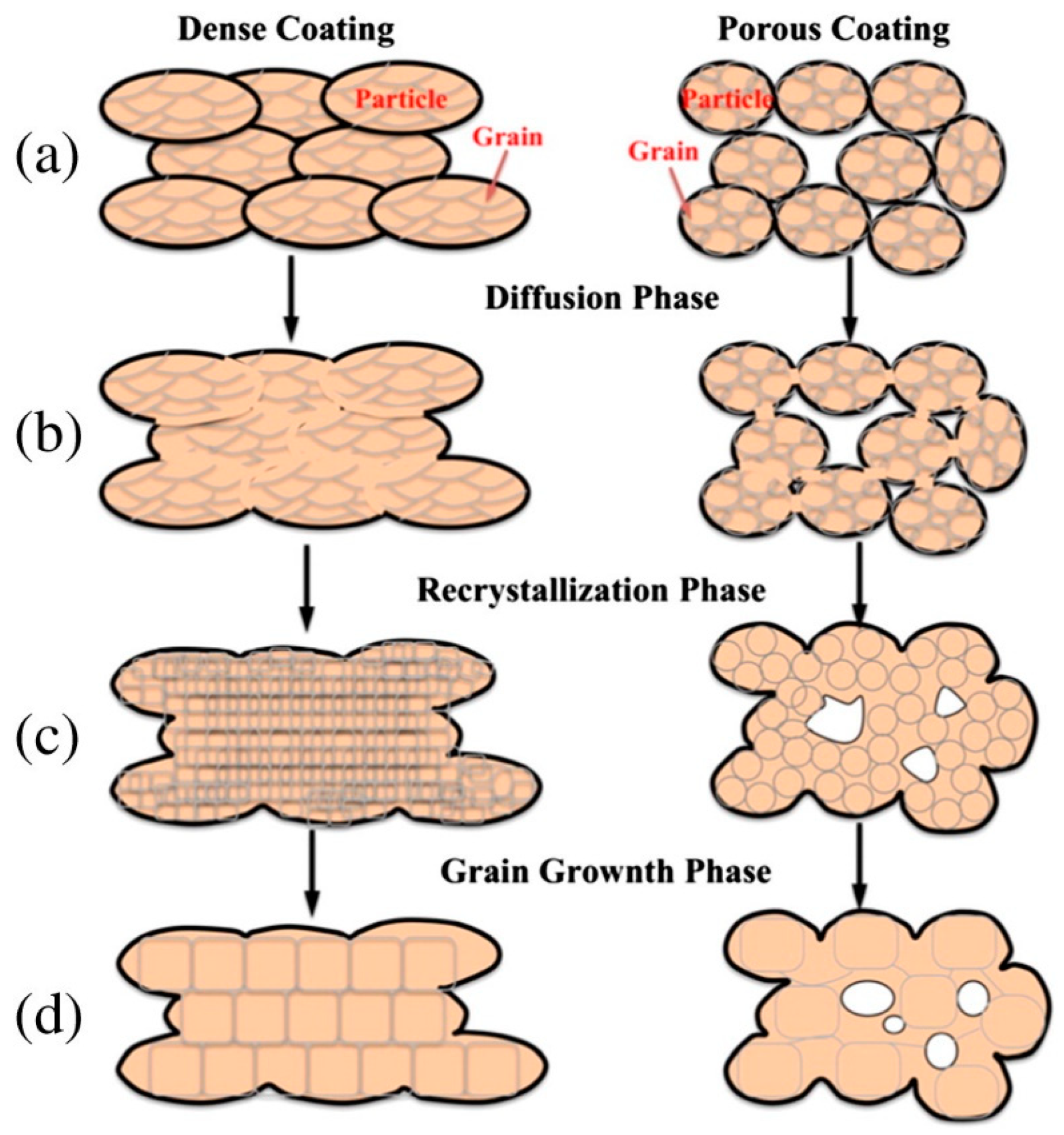
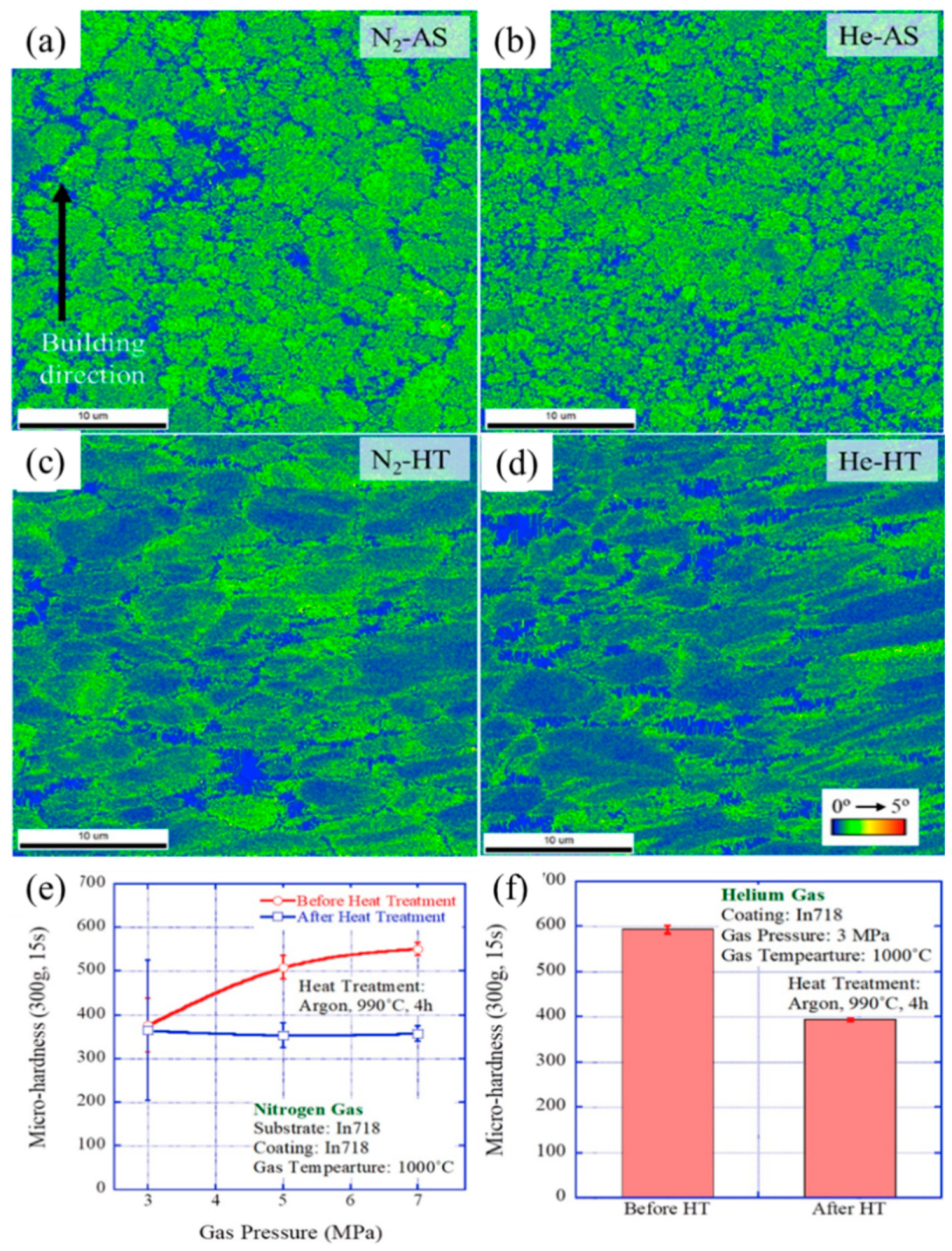


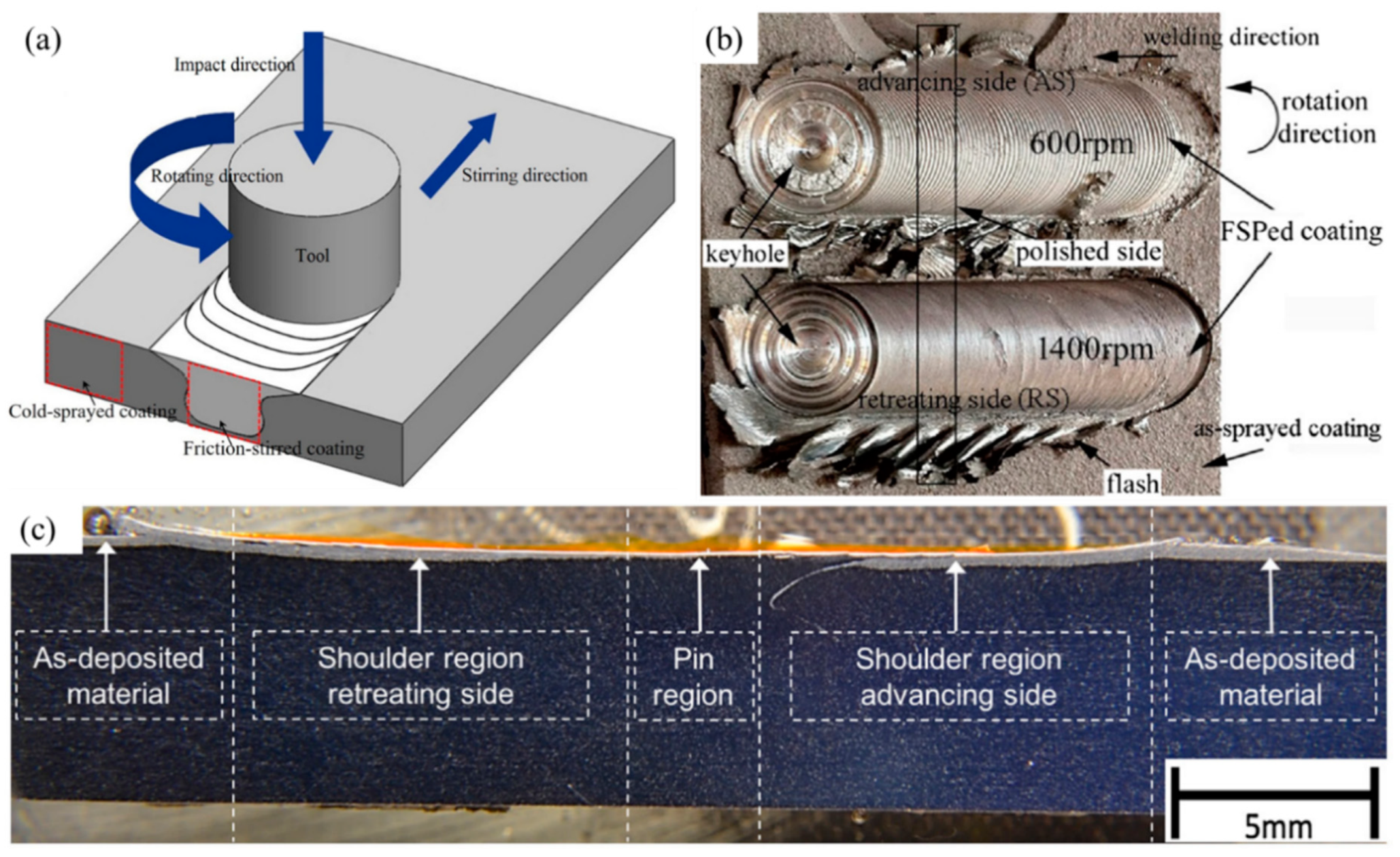
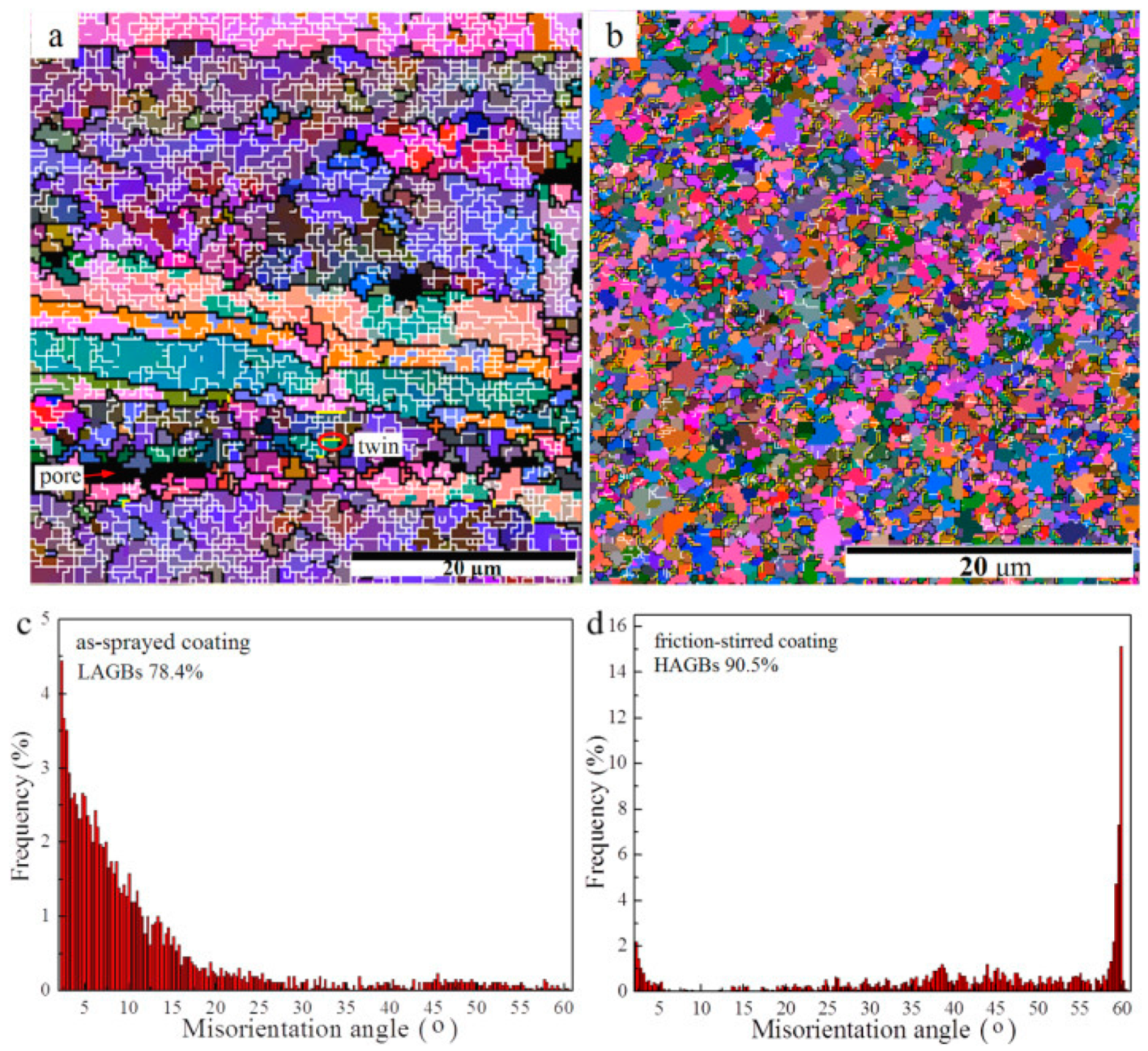
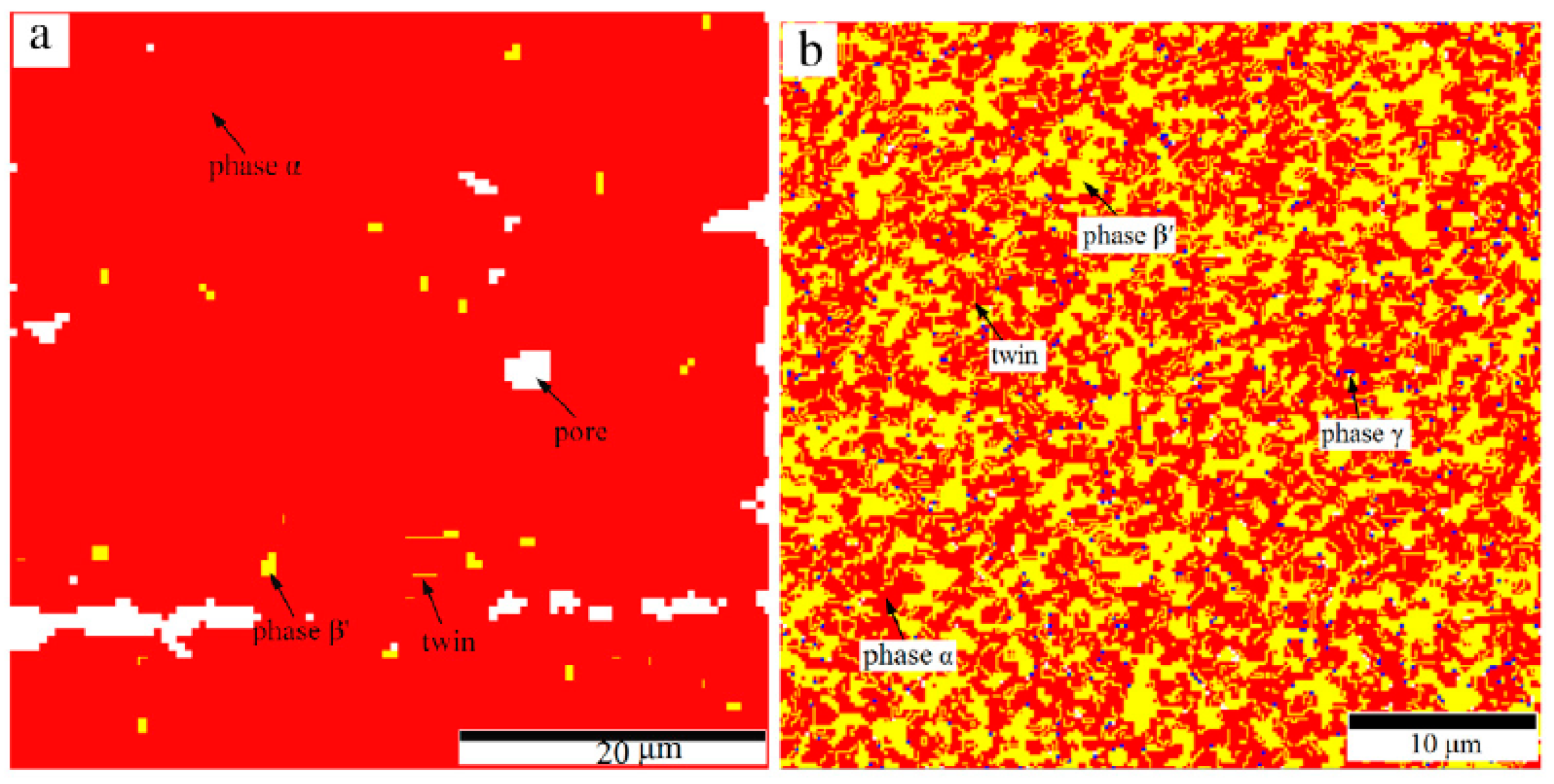
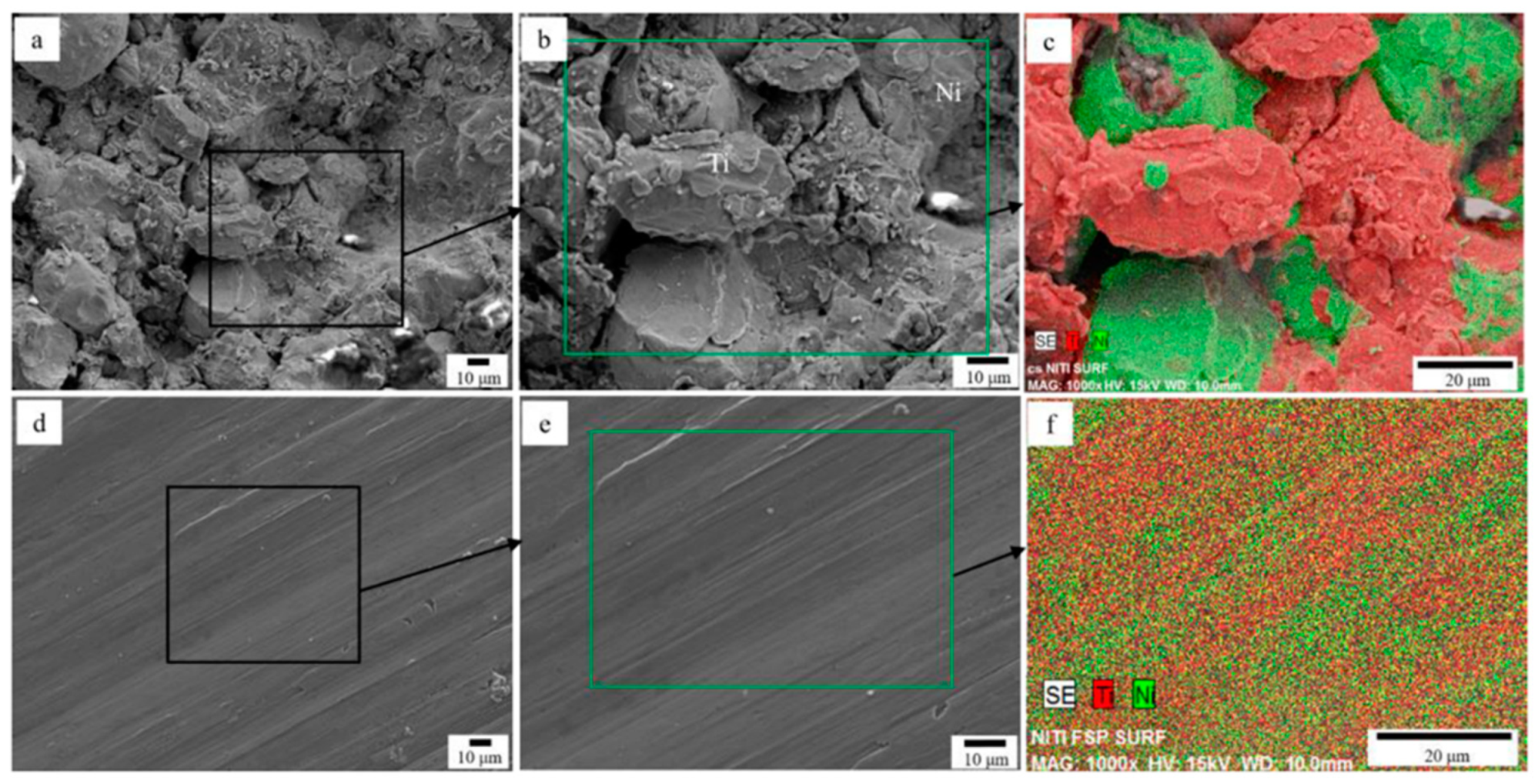
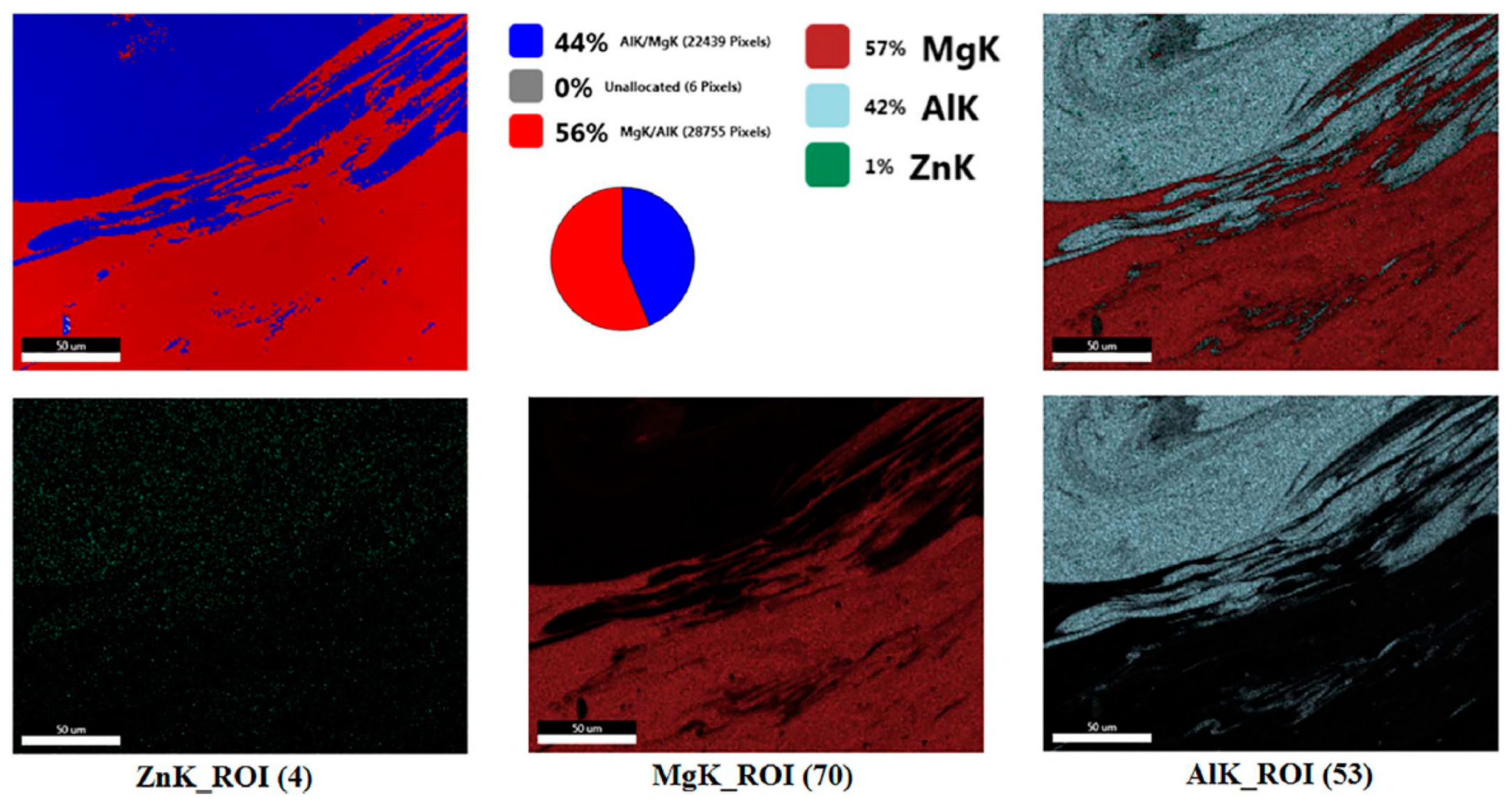
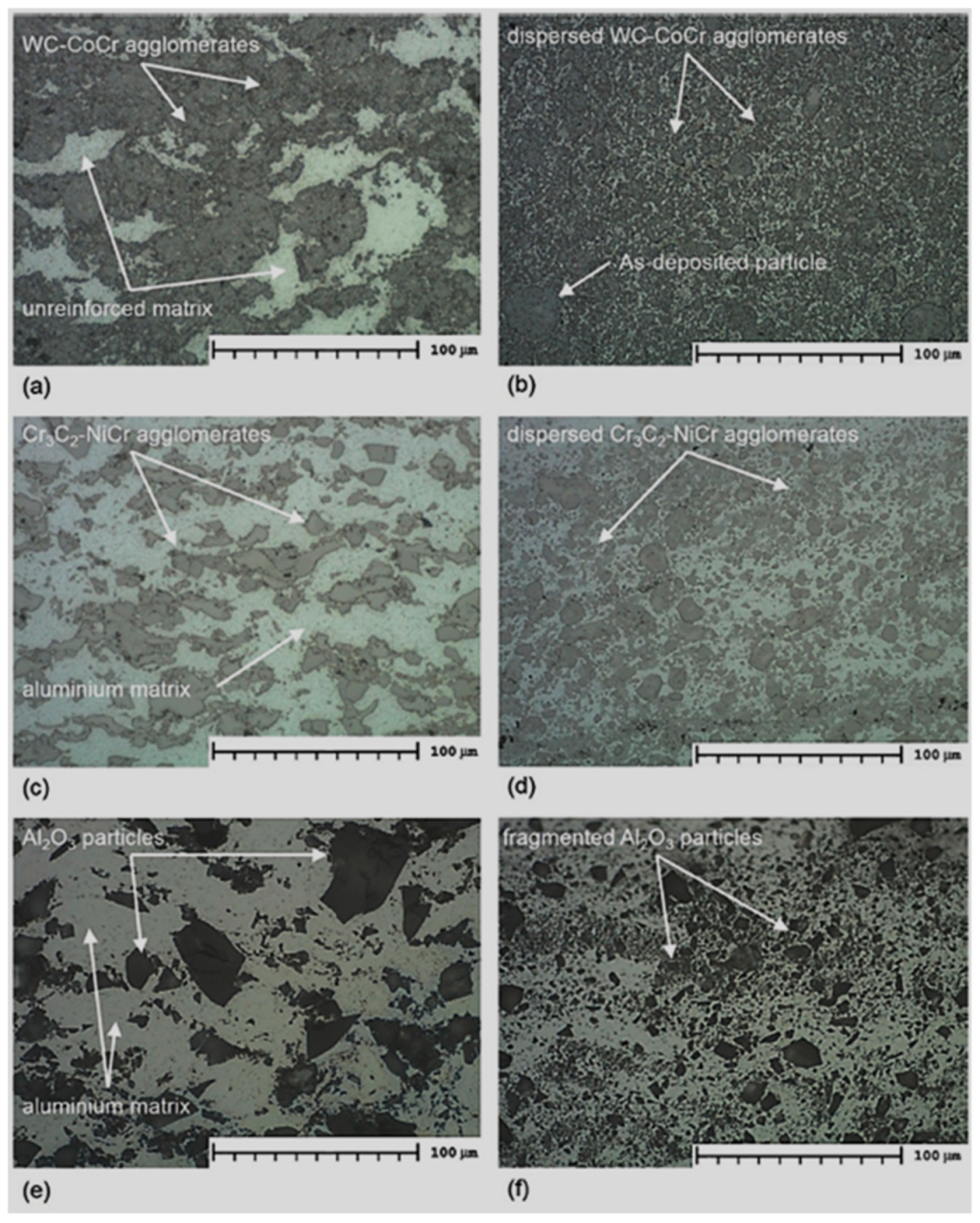
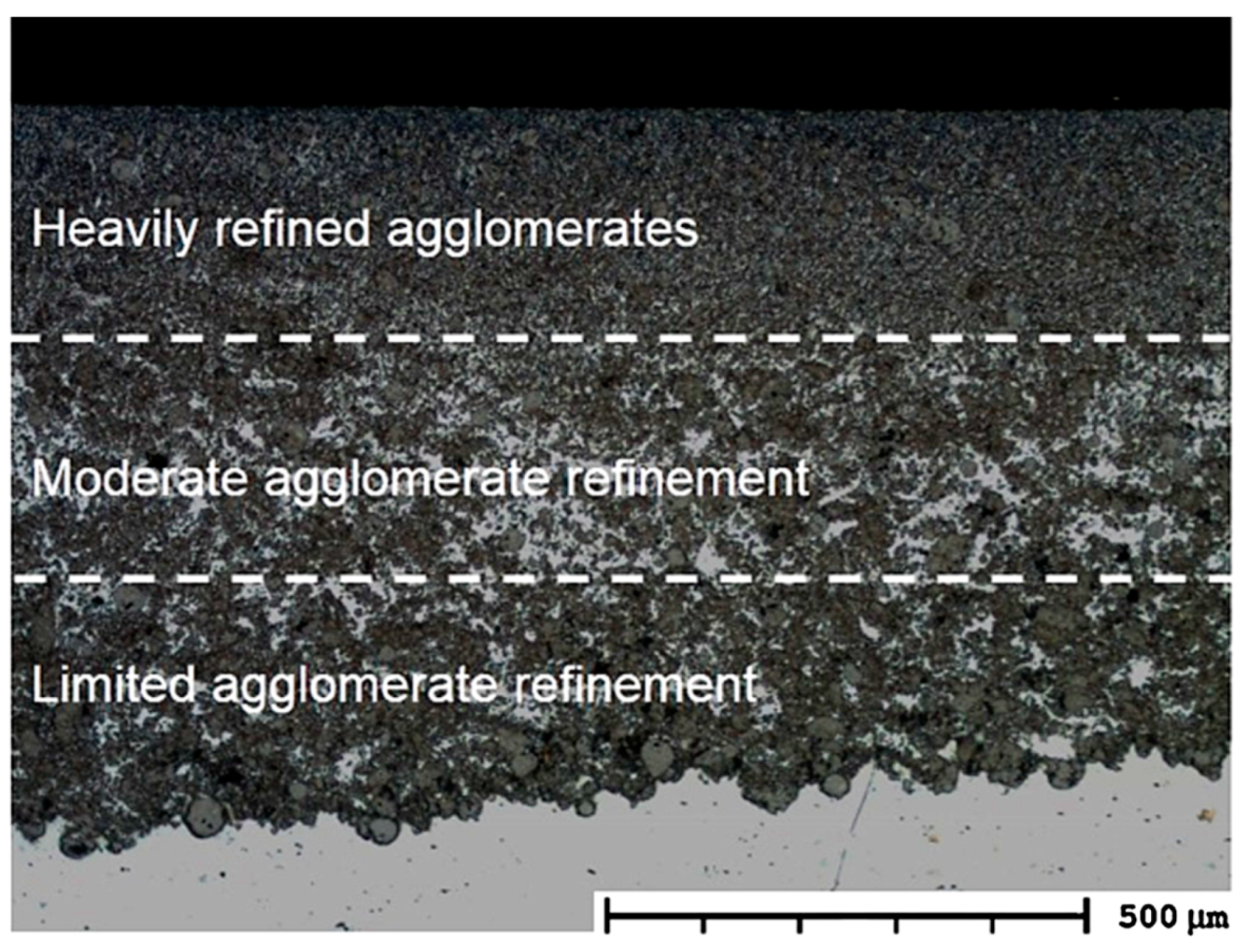
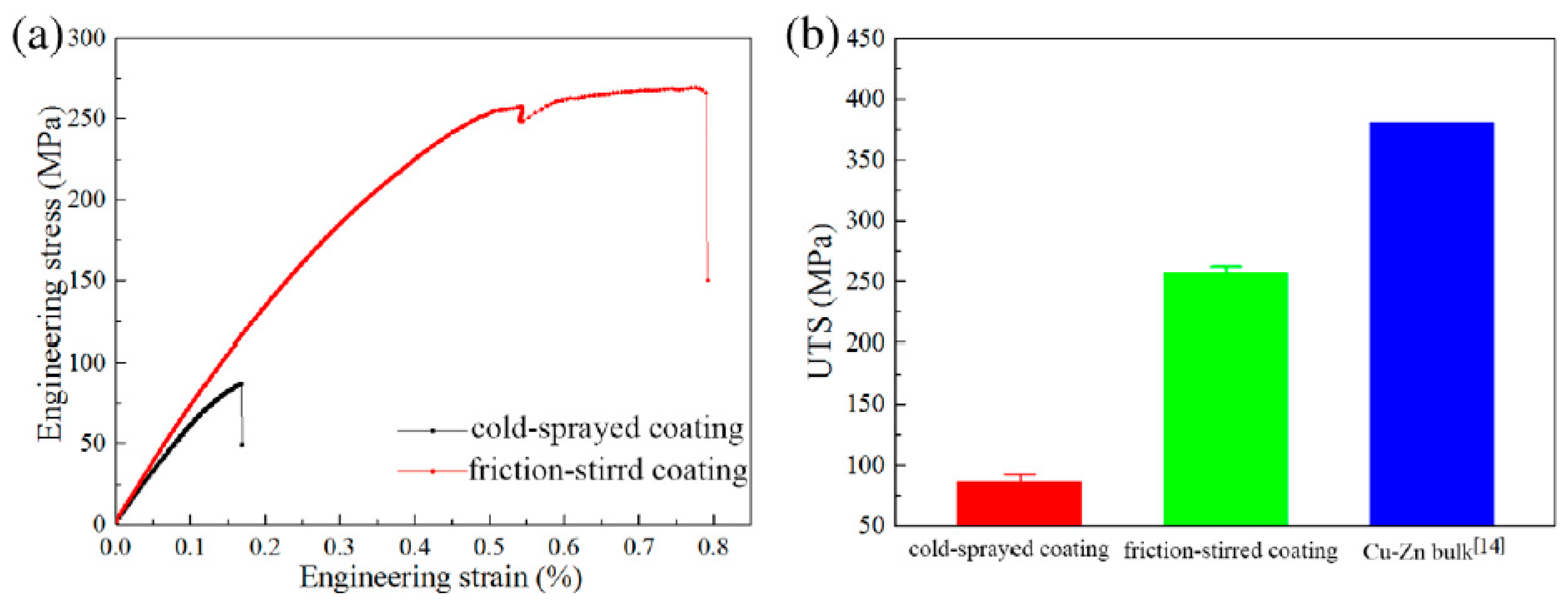
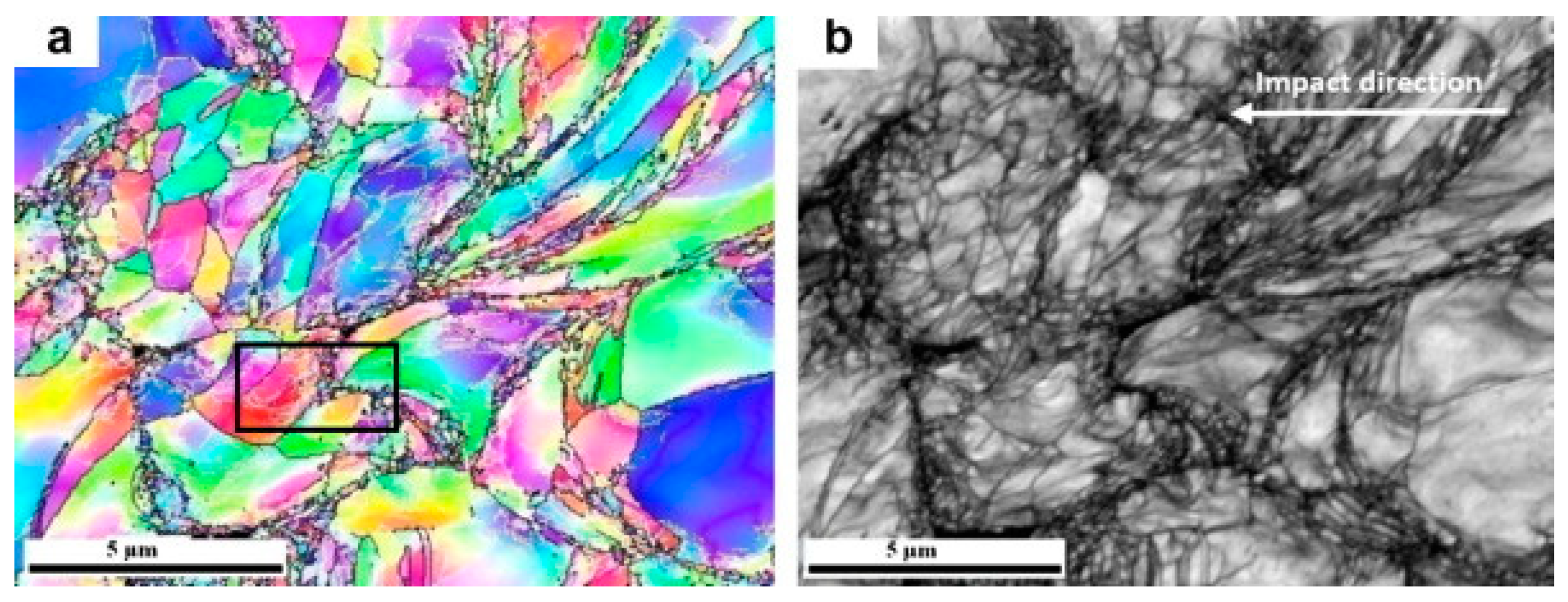

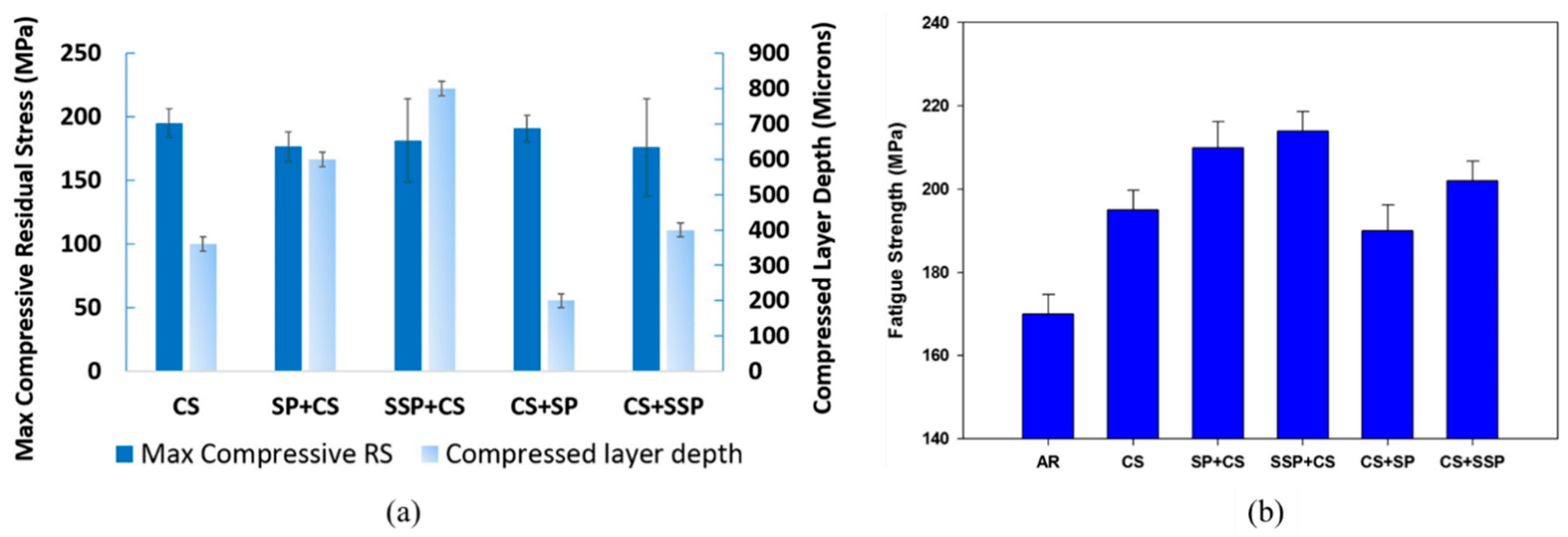
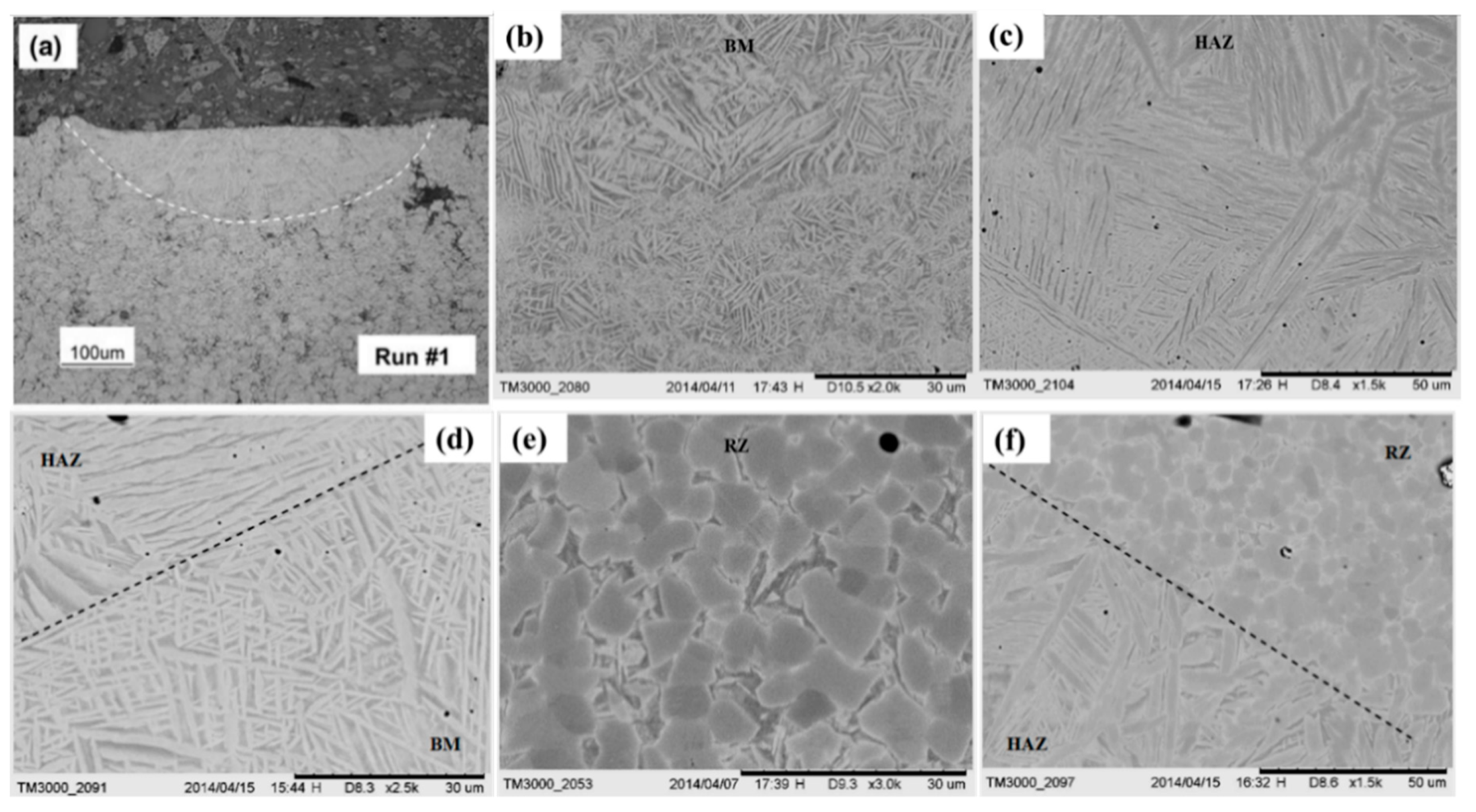
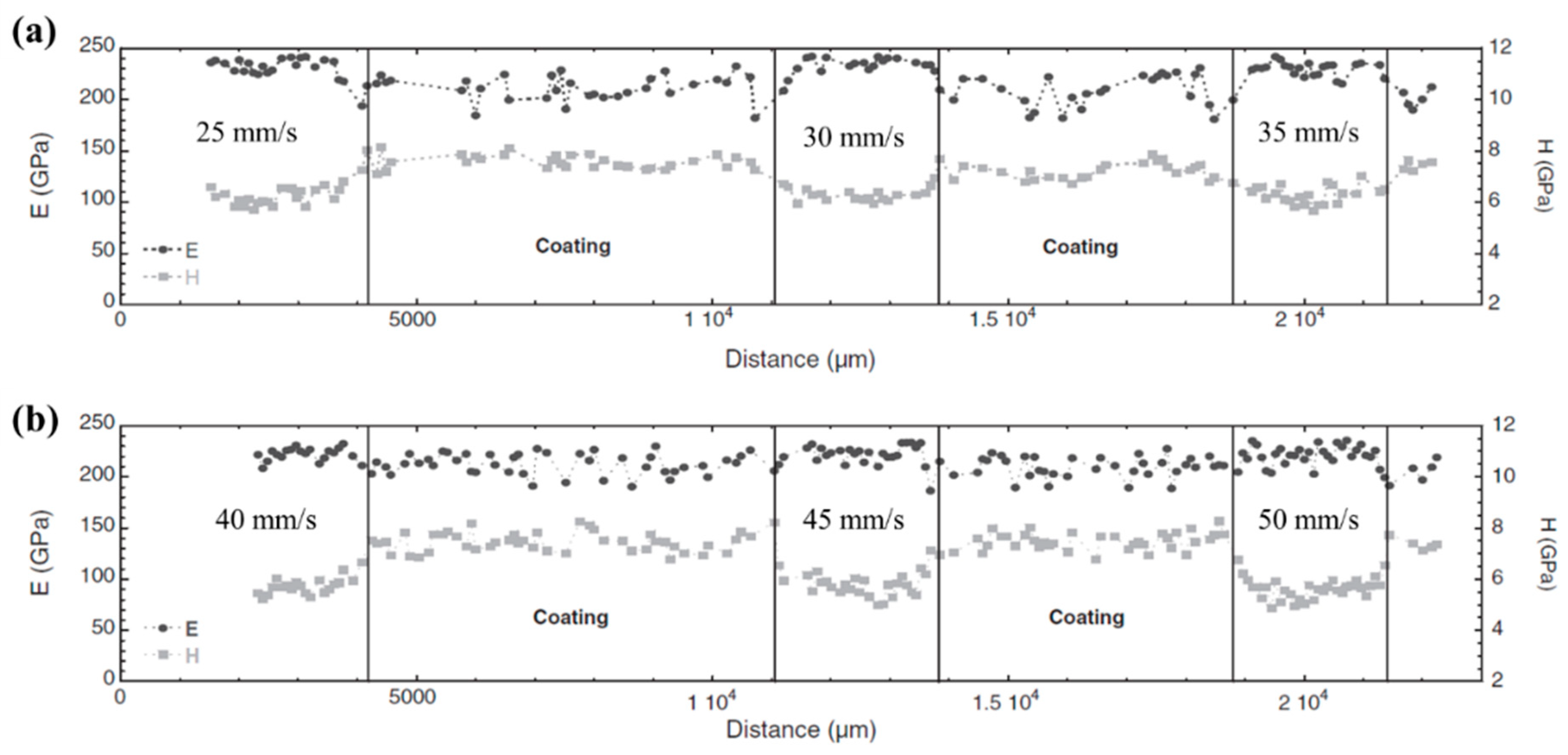
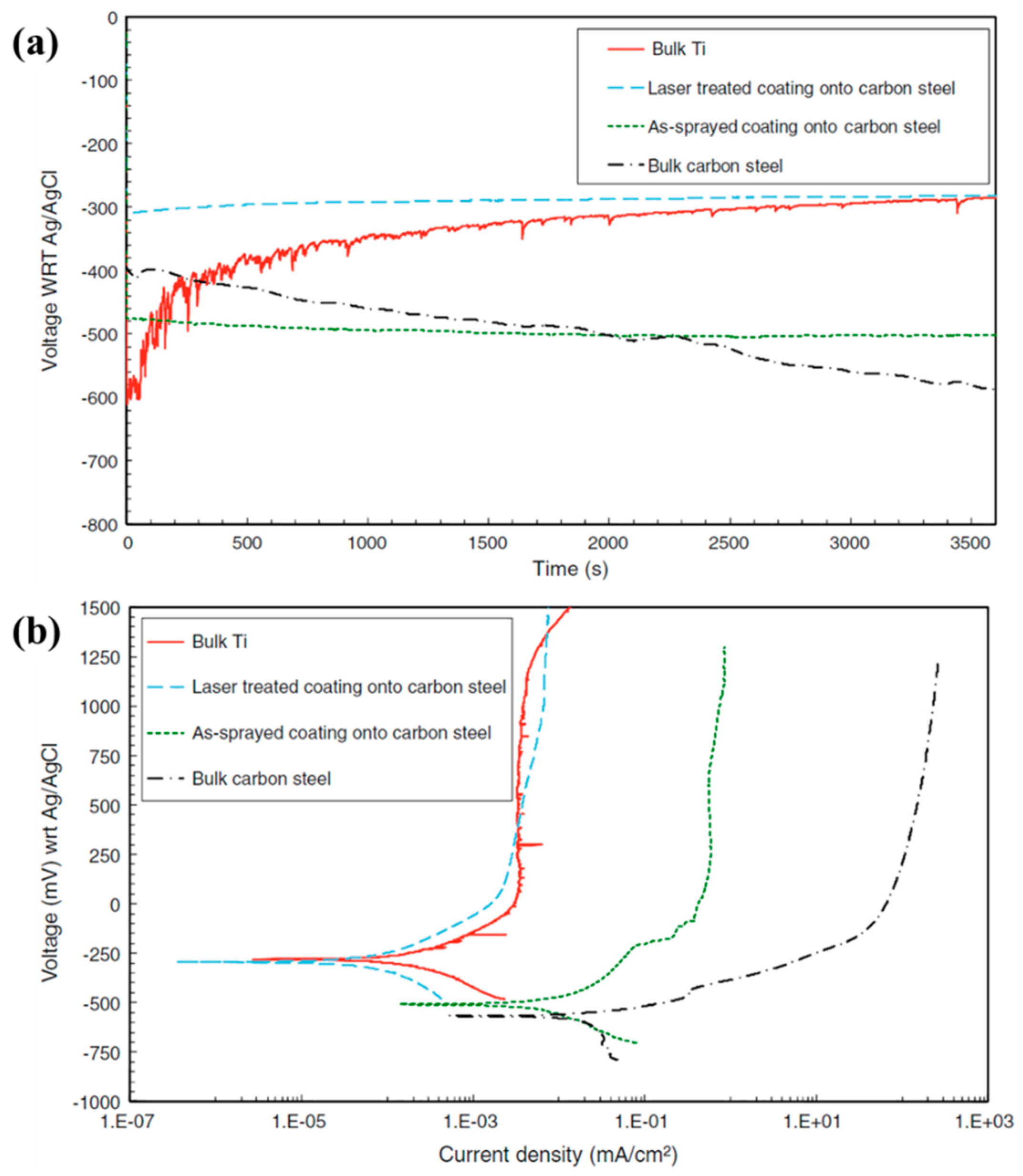
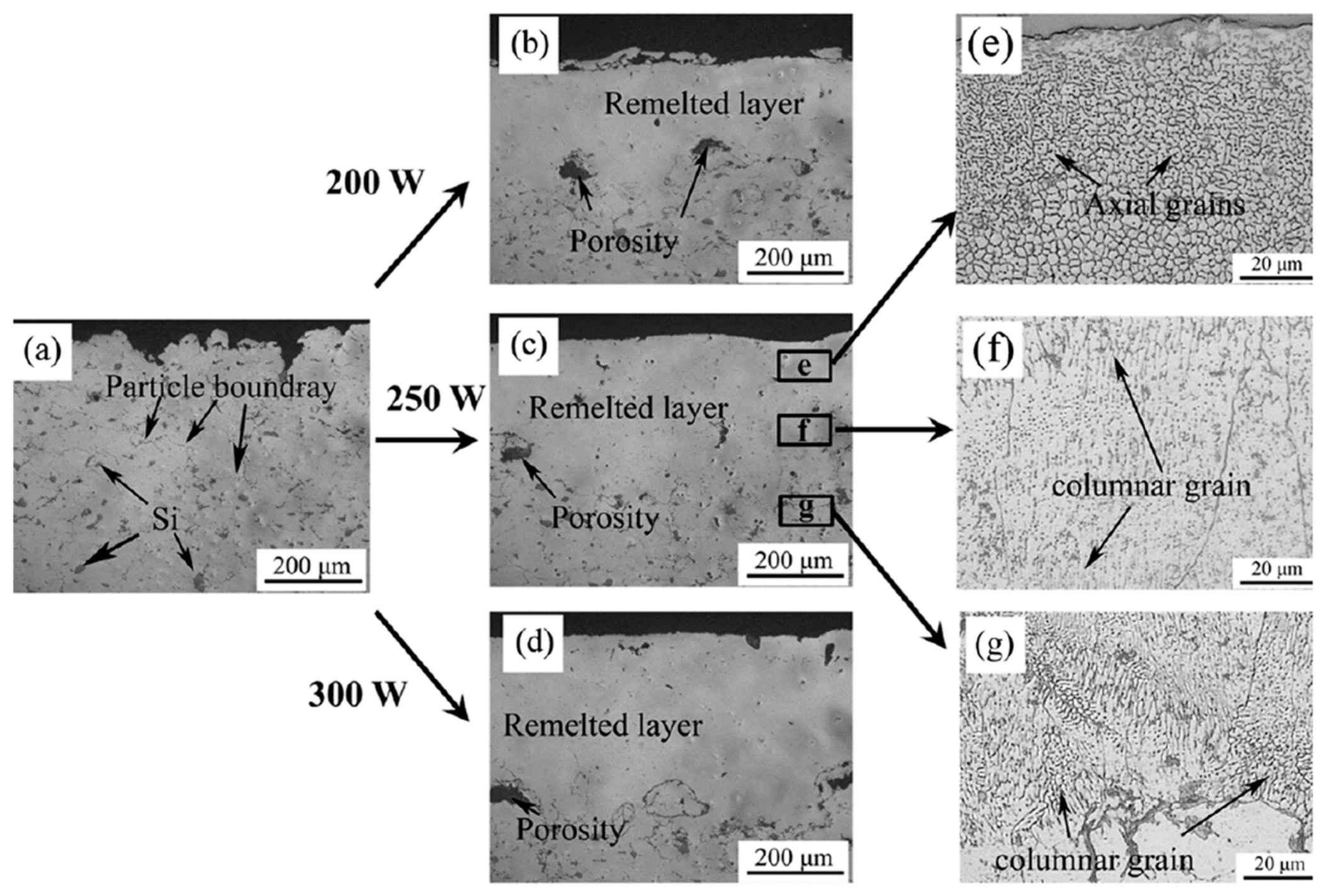
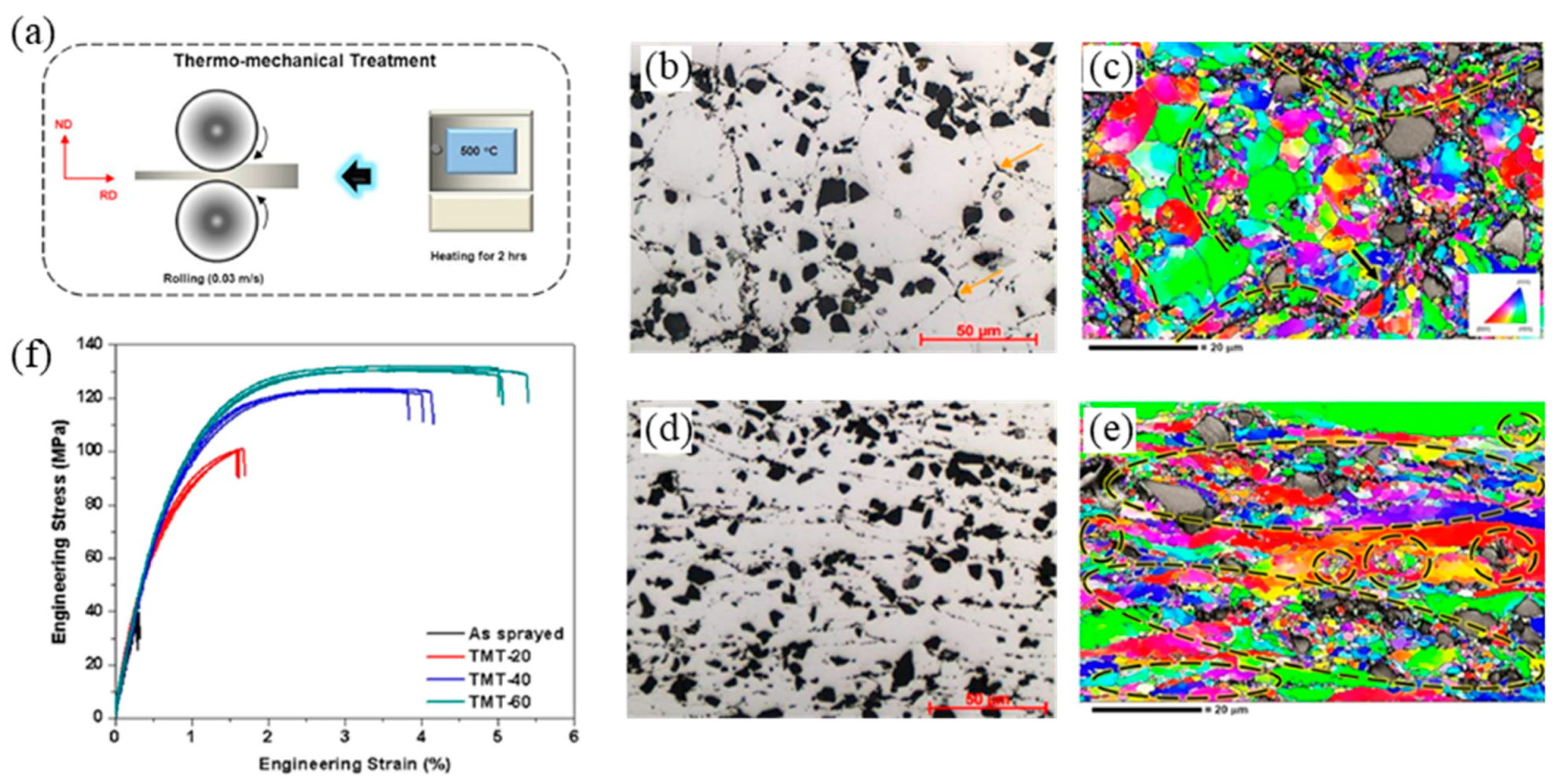

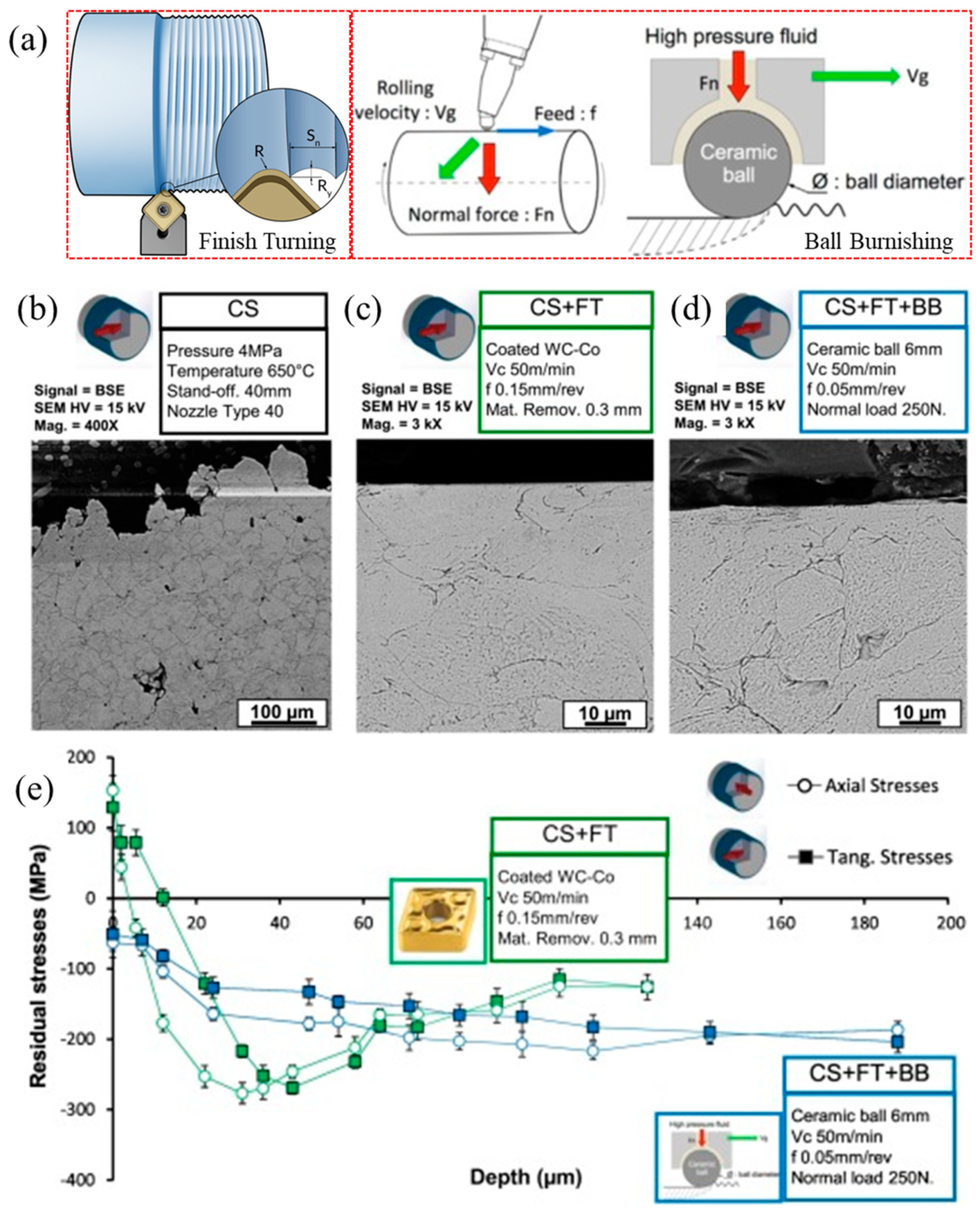
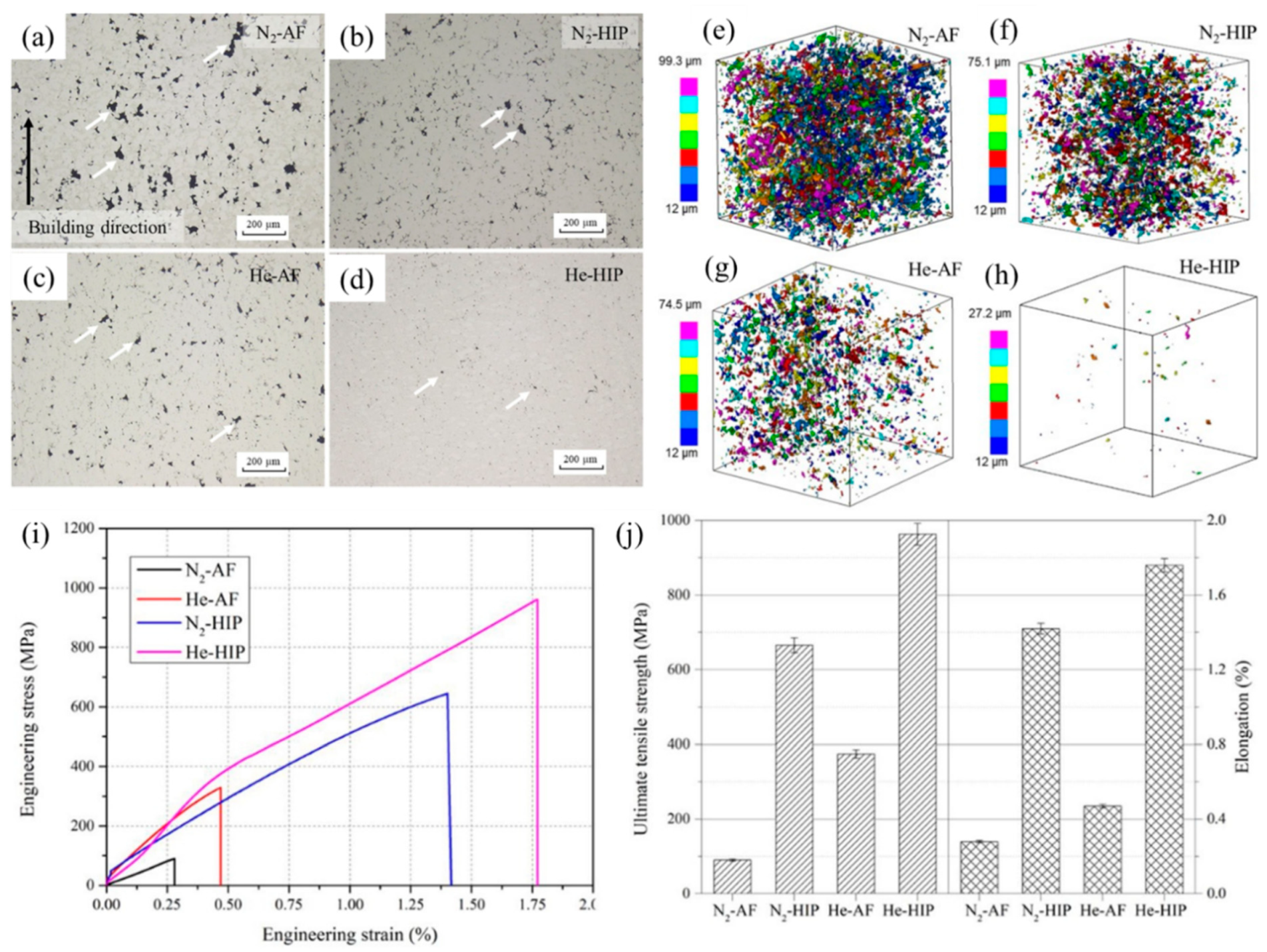
| Coatings | References | HT Parameters | Main Findings |
|---|---|---|---|
| Cu | [24] | Temperature: 300 °C Duration: 1 h Atmosphere: vacuum, air | The electrical conductivity of the coatings after HT was comparable to bulk materials. Vacuum condition during HT yielded lower porosity and higher conductivity of the coatings. |
| Cu | [29] | Temperature: 300–700 °C Duration: 3 h Atmosphere: Ar | The microstructural and mechanical anisotropies in the coatings were relieved after HT. HT could effectively decrease the anisotropy of tensile strength. While, its effect on elongation anisotropy was very limited. |
| Cu-4Cr-2Nb | [30] | Temperature: 250–950 °C Duration: 2 h Atmosphere: vacuum | The microhardness of the coatings was the highest after HT at 350 °C due to the formation of Cr2Nb and gradually decreased with increasing HT temperature due to coarsening of the Cr2Nb phase and softening of the Cu matrix. |
| Al6061 | [31] | Temperature: 176 °C Duration: 1 h, 8 h Atmosphere: air | After HT, the UTS of the coatings was improved because of the formation of strengthening precipitates and the localized improvement in metallurgical bonding. |
| Al-25Ni Al-25Ti | [32] | Temperature: 450–630 °C Duration: 4 h Atmosphere: N2 | Well dispersed intermetallic compounds were formed in the coatings after HT, leading to increased hardness of the coatings. |
| Al | [23] | Temperature: 400 °C Duration: 20 h Atmosphere: Ar | An Al3Mg2 or Mg17Al12 intermetallic compound layer was formed at the coating/substrate interface, which was significantly harder than the aged AZ91 alloy and offered a corrosion resistance similar to that of the Al alloys. |
| Fe-40Al | [33] | Temperature: 650–1100 °C Duration: 5 h Atmosphere: Ar | After HT, a Fe-Al intermetallic compound was formed within the coating, and the erosion resistance of the coating increased since the erosion mechanism was converted from spalling off to micro-cutting and ploughing of erosive particles. |
| SS316L | [26] | Temperature: 1000 °C Duration: 4–8 h Atmosphere: Air, vacuum | Enhanced mechanical properties of the coatings were mainly dominated by improved inter-particle bonding and particle grain structure rather than reduction of porosity. Air annealing only slightly improved the tensile strength and ductility of the SS316L deposits. Vacuum annealing significantly improved the tensile strength and ductility of the SS613L deposits. |
| SS304 | [34] | Temperature: 600–950 °C Duration: 1 h Atmosphere: vacuum | Annealing treatment healed up the weakly bonded interfaces and changed the particle bonding mechanism from mechanical interlocking to metallurgical bonding under certain annealing conditions. |
| Ti | [27] | Temperature: 600 °C Duration: 1 h Atmosphere: vacuum, Ar, 5%H2 + Ar | Among the three HT environments, vacuum could promote the highest hardness and the lowest porosity of the coatings. |
| Ti | [35] | Temperature: 850 °C Duration: 4 h Atmosphere: Ar | Micro-CT analysis showed that the majority of the pores in the coatings after HT were smaller than those in the as-sprayed coatings. |
| Ti-WC | [36] | Temperature: 550–650 °C Duration: 1 h Atmosphere: Ar | After HT, coating porosity dropped. The hardness and wear resistance of the coatings increased due to the formation of TiC phase. |
| IN718 | [37] | Temperature: 900 °C Duration: 10 min Atmosphere: vacuum | Compared with traditional furnace HT, eddy current HT was used, which was more efficient in promoting atomic diffusion and mass transport between the particles in the coatings, thus leading to a higher strength of the coatings. |
| IN718 | [38] | Temperature: 990 °C Duration: 4 h Atmosphere: Ar | A high-performance of the coatings after HT was achieved with the adhesive strength between coatings and substrates being comparable with the tensile strength of the bulk materials after HT. |
| IN718 | [39] | Temperature: 950-1250 °C Duration: 1–2 h Atmosphere: 10% H2 + Ar | The ultimate tensile strength of the coatings after HT was about 62% of that of the bulk materials and the elongation of the coatings exceeded that of the bulk materials. |
| Nb | [25] | Temperature: 500–1250 °C Duration: 1 h Atmosphere: Ar | After HT, coating porosity was eliminated, and inter-particle boundaries in the coatings were closed. The elastic modulus and tensile strength of the coatings were close to those of the bulk materials after HT at above 1250 °C. |
| Ni/FeSiAl | [40] | Temperature: 200–800 °C Duration: 2 h Atmosphere: Ar | The soft magnetic performance of the coatings was significantly improved via stress relief and grain growth after proper HT. |
| Coatings | References | FSP Parameters | Main Findings |
|---|---|---|---|
| AA7075 | [60] | Shoulder diameter: 12 mm; Concave shoulder angle: 3°; Pin diameter: 1.7 mm; Pin height: 1.5 mm | After FSP, the hardness of the coatings was improved by three times and the coating/substrate bonding strength was improved by material intermixing. |
| AA2024/Al2O3 composite | [61] | Stir tool material: H13 steel; Shoulder diameter: 10 mm; Concave shoulder angle: 2.5°; Pin diameter: 3.4 mm; Pin height: 2.9 mm; Rotation speed: 900 rpm; Traverse speed: 50 mm/min | FSP significantly reduced the Al2O3 particles size and effectively enhanced the corrosion resistance of the coatings. |
| AA2024/Al2O3 | [62] | Stir tool material: H13 steel; Concave shoulder angle: 2.5°; Shoulder diameter: 10 mm; Pin diameter: 2.9 mm; Pin height: 3.4 mm; Rotation speed: 900–1500 rpm; Traverse speed: 100 mm/min | The fragmentation level increased with rotation speed. FSP could effectively improve the UTS and elongation of the MMC coatings. |
| WC-CoCr/Al2O3 (Cr3C2-NiCr/Al2O3) | [56] | Stir tool material: H13 steel; Concave shoulder angle: 3°; Pin diameter: 2 mm; Pin height: 2 mm; Rotation speed: 600 rpm; Traverse speed: 272 mm/min | FSP resulted in substantial refinement of the reinforcing particles and reduced interparticle spacing for each reinforcing particle and increased the average hardness of the coatings. |
| WC-CoCr/Al2O3 | [57] | Stir tool material: W-Re/pcBN; Concave shoulder angle: 2°/0; Shoulder diameter: 18 mm /25.4 mm; Pin diameter: 5 mm; Pin height: 5.7 mm/5.75 mm; Rotation speed: 250 rpm/800 rpm; Traverse speed: 100 mm/min/76 mm/min | FSP resulted in the dispersion of the as-deposited WC-CoCr agglomerates and refinement of the Al2O3 particles. FSP improved the hardness homogeneity as well as the anti-erosion performance of the coatings. |
| Ti | [63] | Stir tool material: WC; Concave shoulder angle: 2.5°; Shoulder diameter: 12 mm; Rotation speed: 900 rpm; Traverse speed: 630 mm/min | FSP aided the formation of a titanium aluminide (Al3Ti) intermetallic layer at the Ti coating/Al substrate interface. |
| Cu60-Zn40 | [59] | Concave shoulder angle: 2.5°; Shoulder diameter: 10 mm; Pin diameter: 3.4 mm; Pin height: 1.5 mm; Rotation speed: 1500 rpm; Traverse speed: 100 mm/min | The friction-stirred coatings contained mainly HAGBs and twin boundaries with the tensile strength of coating improved. |
| Ni50-Ti50 | [64] | Stir tool material: W-Re Concave shoulder angle: 2.5°; Shoulder diameter: 15 mm; Rotation speed: 1500 rpm; Traverse speed: 100 mm/min | After FSP, Ni-Ti intermetallic compounds were formed, leading to the significantly improved microhardness and wear resistance of the coatings. |
| SiCp/Al5056 | [58,65] | Stir tool material: W-Re; Concave shoulder angle: 2.5°; Shoulder diameter: 10 mm; Pin diameter: 3.4 mm; Pin height: 2.9 mm; Rotation speed: 600–1400 rpm; Traverse speed: 100 mm/min | After FSP, fragmented SiC particles were homogenously distributed in the coatings. The Al matrix particles were substantially refined to form the fine and equiaxed grains. The microhardness and anti-friction performance of the coatings were improved. |
| Al–Al2O3 | [66] | Stir tool material: W-Re; Concave shoulder angle: 3°; Shoulder diameter: 12 mm; Rotation speed: 894–1723 rpm; Traverse speed: 88 mm/min | After FSP, the coating hardness increased due to the re-distribution of the Al2O3 particles in the coatings. |
| Coatings | References | SP Parameters | Main Findings |
|---|---|---|---|
| Pure Al and Al/Al2O3 composite coatings | [71] | Ball Material: S230 cast iron | Shot peening was not able to considerably influence the residual stress state of the coatings. The application of shot peening was able to induce work hardening to the coating top layer. |
| Diameter: 0.6 mm | |||
| Stand-of-Distance: 380 mm | |||
| Pressure: 1.5 bar | |||
| Exposure time: 33 s | |||
| Coverage: 200% | |||
| Al 6082 | [72] | Ball Material: S230 cast iron | Post shot peening could not induce compressive residual stresses in the coatings. Instead, the peening caused damage in the coatings due to the presence of weakly bonded particles. The conventional or severe shot peening as post-treatment was not able to increase the fatigue strength of the coated specimens. |
| Diameter: 0.6 mm | |||
| Stand-of-Distance: 380 mm | |||
| Intensity: “Almen A” strip with 6-8 | |||
| (thousandth of an inch) | |||
| Coverage: 100% and 800% | |||
| NiCrAlY | [73] | Ball Material: glass bead grit | The surface roughness of the coatings was significantly reduced after shot peening, which promoted the formation of a uniform oxide layer on the coating surfaces. |
| Diameter: 0.3 mm | |||
| Stand-of-Distance: 150 mm |
| Coatings | References | LR Parameters | Main Findings |
|---|---|---|---|
| Ti | [81,82] | Spot diameter: 2 mm | After LR, three different metallurgical zones were observed: a re-melted zone (RZ), a heat affected zone (HAZ) and the base material (BM). |
| Scan speed: 10–1000 mm/s | |||
| Laser power: 200 W | |||
| CP-Ti grade 2 | [83] | Spot diameter: 0.3–1.08 mm | The laser-treated regions were pore-free with the equiaxed grains. The laser-treated Ti coatings performed like a high-quality barrier layer that improved their anti-corrosion performance. |
| Scan speed: 21.6–48.3 mm/s | |||
| Laser power: 440–1000 W | |||
| Ti-6Al-4V | [80] | Spot diameter: 1 mm | The laser treated Ti64 coatings with a higher laser power had a higher surface hardness. The tribological properties of the laser treated Ti64 coatings were significantly influenced by the laser power. |
| Scan speed: 20 mm/s | |||
| Laser power: 50–200 W | |||
| Al | [85] | Spray distance: 250 mm | After LR, the fine porosities and micro-cracks in the coatings were eliminated, and the grains were refined. The Al coating hardness and wear resistance were enhanced after LR. |
| Spot diameter: 5 mm | |||
| Laser power: 800 W | |||
| Flow rate of Ar gas: 8 L/min | |||
| Inconel 625 | [84] | Scan speed: 25–50 mm/s | After LR, the coating porosity was reduced and the coating elastic modulus increased, while the coating hardness was reduced due to the formation of a columnar dendritic microstructure. |
| Heat input: 14–28 J/mm | |||
| Laser power: 700 W | |||
| Al-Si coating | [86] | Spot diameter: 40 µm | After LR, the coating microstructure was significantly refined, and the coating surface roughness was lowered. An Al phase supersaturated with Si was formed in the coatings after FSP. |
| Hatch distance: 50 µm | |||
| Scan speed: 1000 mm/s | |||
| Laser power: 200–300 W |
| Laser Scan Speed (mm/s) | Microhardness (HV) | ||
|---|---|---|---|
| RZ | HAZ | BM | |
| 200 | 480 | 130 | 160 |
| 400 | 475 | 134 | |
| 600 | 485 | 128 | |
| 800 | 468 | 125 | |
| 1000 | 473 | 135 | |
| Coatings | References | Post Process | Parameters | Main Findings |
|---|---|---|---|---|
| B4C/Al | [88] | Hot rolling | Heating: ~500 °C for 2 h Rolling: unidirectional at a rolling speed of 0.03 m/s | After hot rolling, recrystallized grains and sub-structured grains were formed in the coatings. The tensile strength and elongation of the rolled coatings were much higher than those of the as-sprayed and conventionally heat-treated coatings. |
| Si/A380 | [89] | Hot rolling | Heating: ~500 °C for 2 h Rolling: unidirectional at a rolling speed of 0.03 m/s | After hot rolling, the reinforcement Si particles were refined and uniformly distributed in the Al matrix. The UTS and elongation of the rolled coatings were significantly improved compared to those of the as-sprayed and conventionally heat-treated coatings. |
| B4C/Al | [90] | Hot compression + Hot rolling | Hot compression: ~500 °C with speed of 0.05 mm/min Hot rolling: ~500 °C for 2 h, followed by rolling speed at 0.03 m/s. | After the hybrid treatment, the Al grains were extensively refined and the B4C particles were homogeneously distributed in the matrix. The tensile strength and elongation of the coatings were simultaneously improved. |
| 17-4PH stainless steel | [91] | Finish turning and ball-burnishing | Finish turning: tungsten carbide tool, cutting speed (50 m/min), feed rate (0.15 mm/rev), depth of cut (0.3 mm). Ball-burnishing: ceramic ball (6 mm diameter), feed (0.05 mm/rev), speed (50 m/min) and load (250 N) | Applying finish turning or ball-burnishing operation affected the near-surface microstructure, resulting in a transformed layer in the coatings. After finish turning, tensile residual stresses were induced at the coating surface. After ball-burnishing, the surface tensile stresses were turned into compressive residual ones. |
| Ti64 | [95] | HIP | Temperature: 920 °C Pressure: 120 MPa Duration: 2 h Gas: Ar | After HIP, the coating porosity was significantly reduced, and the tensile strength of the coatings increased from 150 MPa to 650 MPa. |
| Pure Ti | [96] | HIP | Temperature: 900 °C Pressure: 110 MPa Gas: Ar | After HIP, the coating porosity was decreased from 4.3 to 2.2% and the UTS of the coatings was increased from 110 to 480 MPa. |
| 316L | [26] | HIP | Temperature: 1000 °C Pressure: 150 MPa Gas: Ar Duration: 4 h | After HIP, the coating porosity was significantly decreased and the UTS of the coatings was increased. However, the mechanical properties of HIPed samples did not surpass those of the vacuum-annealed samples. |
© 2020 by the authors. Licensee MDPI, Basel, Switzerland. This article is an open access article distributed under the terms and conditions of the Creative Commons Attribution (CC BY) license (http://creativecommons.org/licenses/by/4.0/).
Share and Cite
Sun, W.; Tan, A.W.-Y.; Wu, K.; Yin, S.; Yang, X.; Marinescu, I.; Liu, E. Post-Process Treatments on Supersonic Cold Sprayed Coatings: A Review. Coatings 2020, 10, 123. https://doi.org/10.3390/coatings10020123
Sun W, Tan AW-Y, Wu K, Yin S, Yang X, Marinescu I, Liu E. Post-Process Treatments on Supersonic Cold Sprayed Coatings: A Review. Coatings. 2020; 10(2):123. https://doi.org/10.3390/coatings10020123
Chicago/Turabian StyleSun, Wen, Adrian Wei-Yee Tan, Kaiqiang Wu, Shuo Yin, Xiawei Yang, Iulian Marinescu, and Erjia Liu. 2020. "Post-Process Treatments on Supersonic Cold Sprayed Coatings: A Review" Coatings 10, no. 2: 123. https://doi.org/10.3390/coatings10020123
APA StyleSun, W., Tan, A. W.-Y., Wu, K., Yin, S., Yang, X., Marinescu, I., & Liu, E. (2020). Post-Process Treatments on Supersonic Cold Sprayed Coatings: A Review. Coatings, 10(2), 123. https://doi.org/10.3390/coatings10020123










